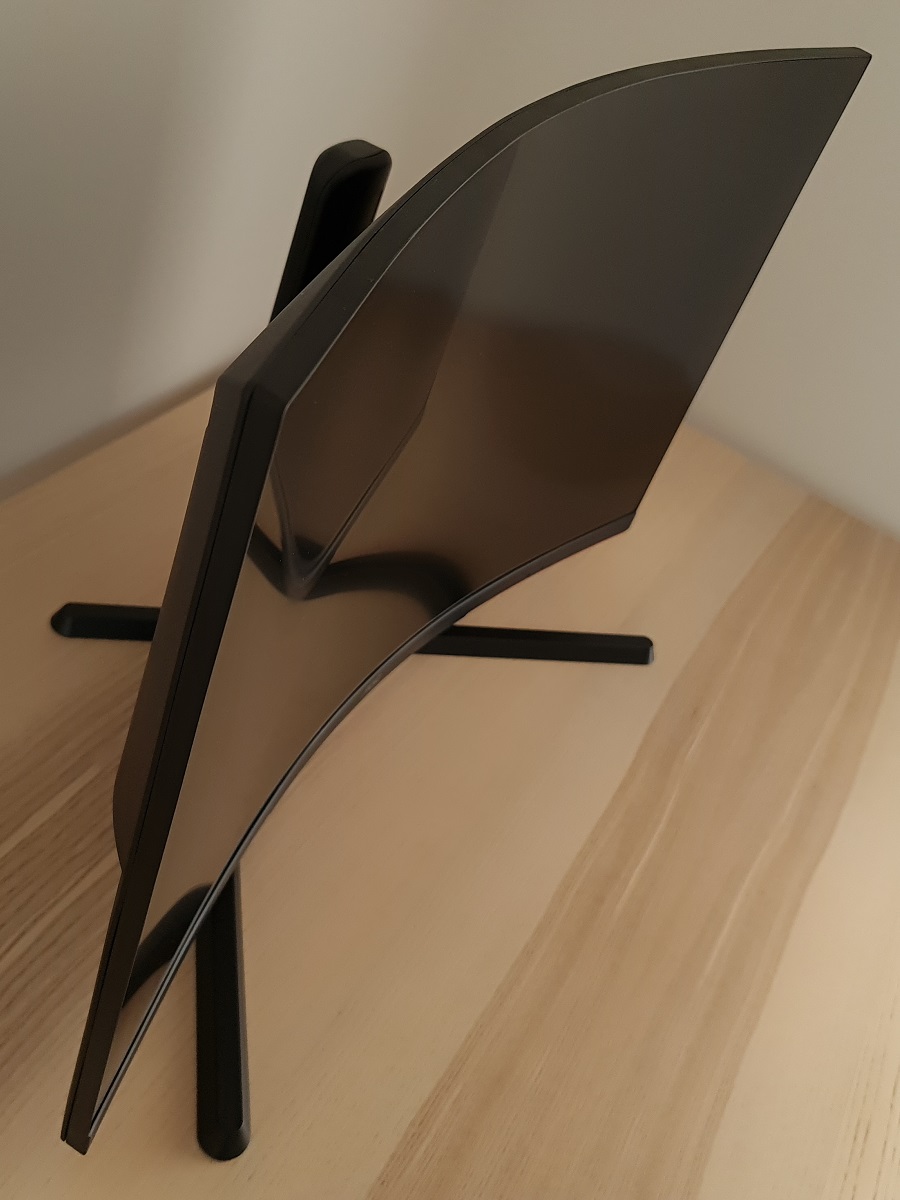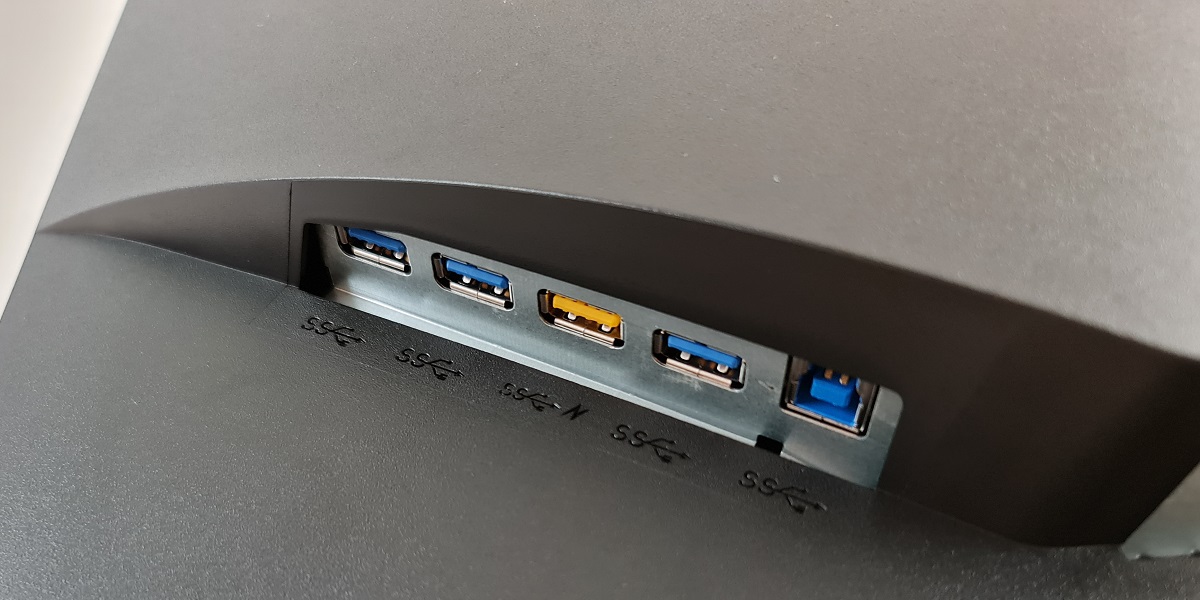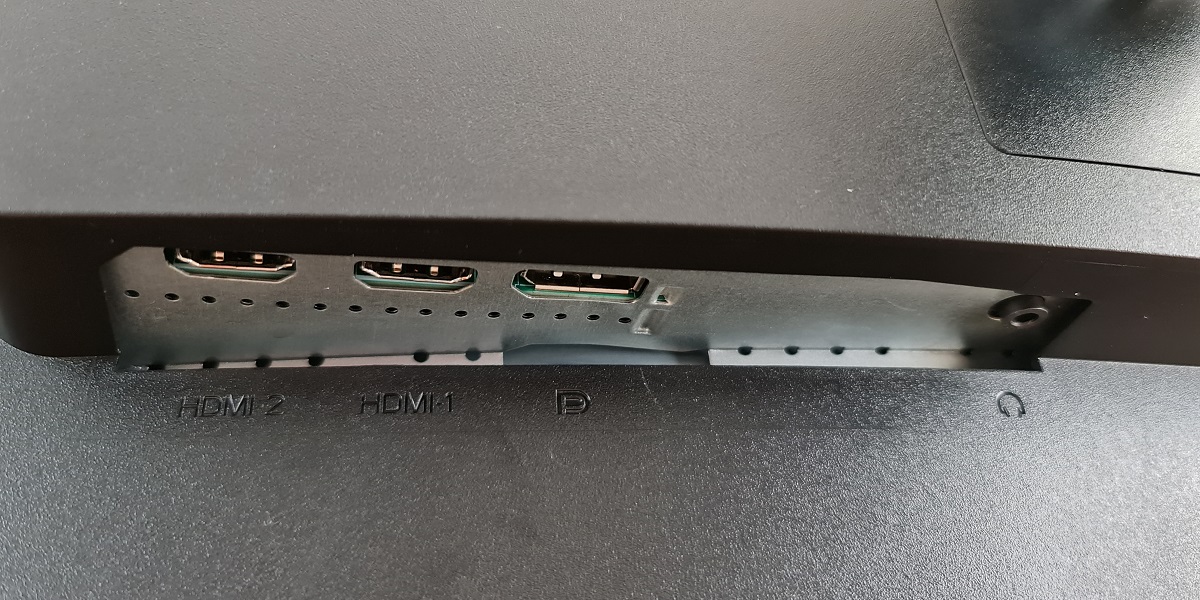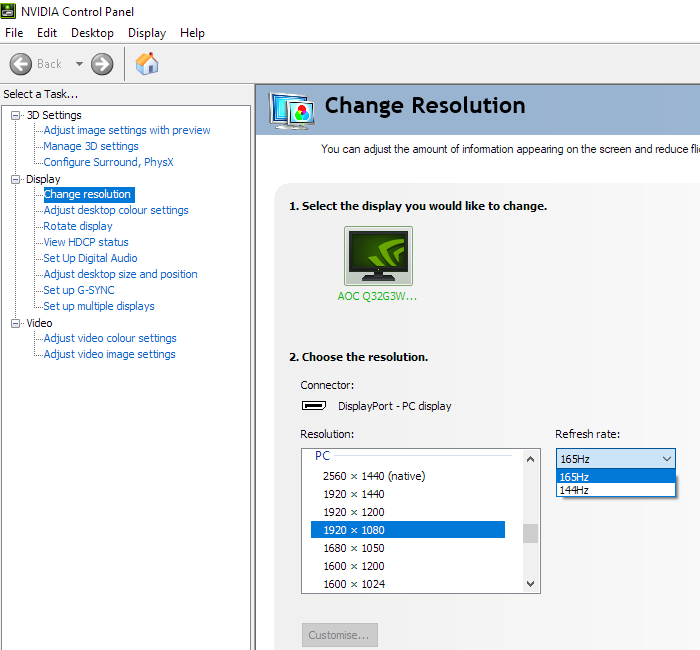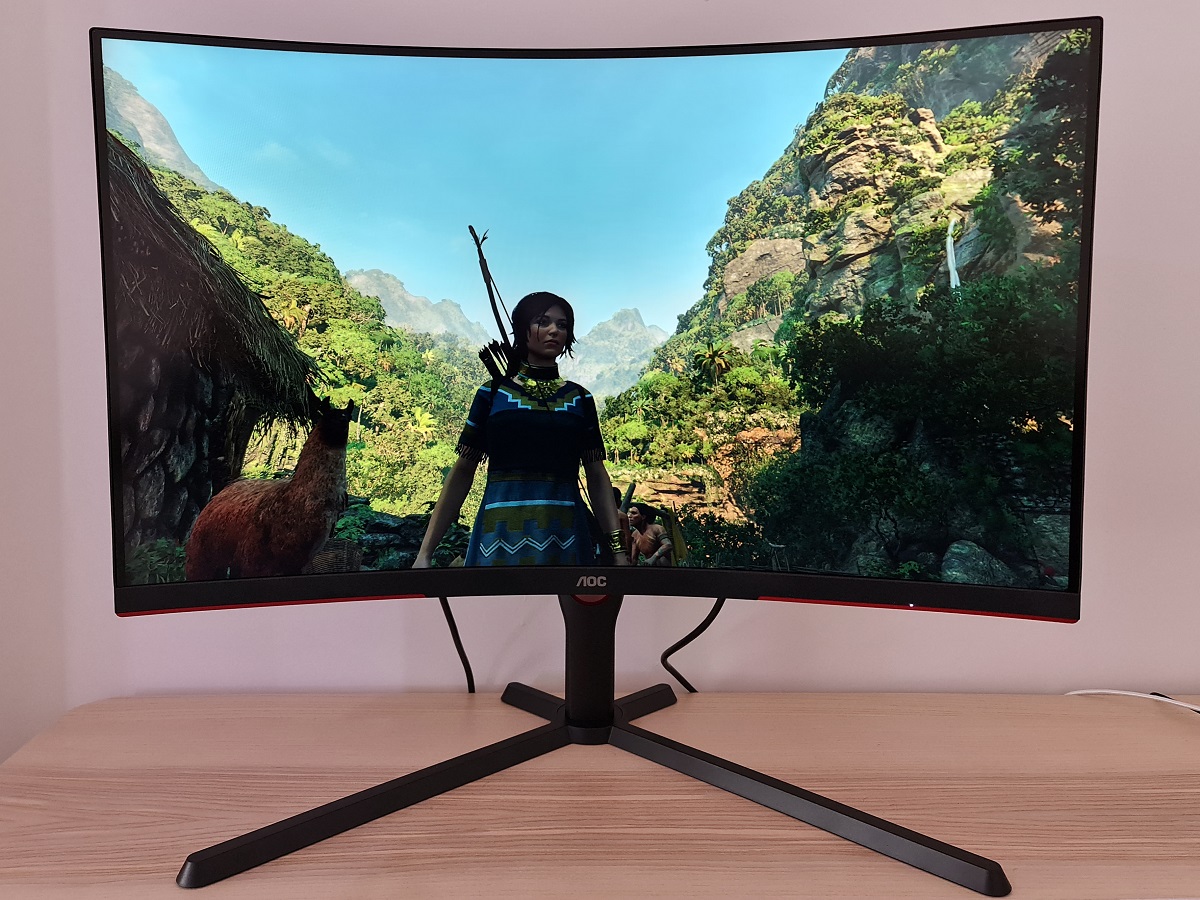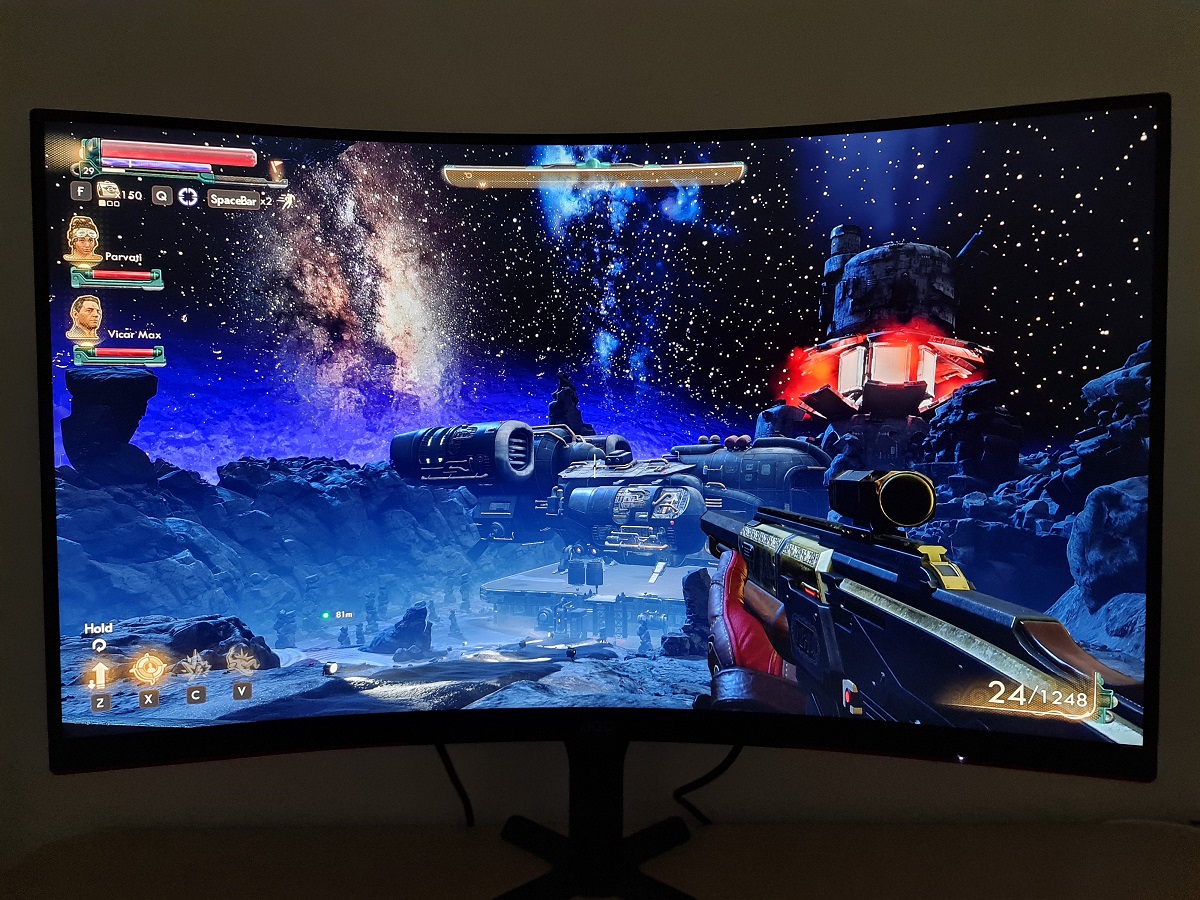Author: Adam Simmons
Date published: October 16th 2021
Table of Contents
Introduction
The combination of ~32” screen size and 2560 x 1440 (WQHD or 1440p) resolution is attractive for those seeking a reasonable pixel density, decent desktop real-estate and strong immersion. The AOC CQ32G3SU (CQ32G3SU/BK owing to mainly black stand) delivers this – sold as the CQ32G3SE (CQ32G3SE/BK) in some markets with cut down stand ergonomics and ports. A 1000R curve is also included to help draw you into the experience. With a focus on gaming, it also delivers a 165Hz refresh rate, Adaptive-Sync support and basic HDR. We put this model through its paces to see how it performs in a range of tasks.
Specifications
The monitor is based on a 31.5” AUO VA (Vertical Alignment) panel with 1000R (relatively steep) curve. A 165Hz refresh rate and 2560 x 1440 (WQHD or 1440p) resolution is supported, alongside true 8-bit colour. A 4ms grey to grey and 1ms MPRT response time is specified, but as usual you shouldn’t pay too much attention to these figures. Some of the key ‘talking points’ for this monitor have been highlighted in blue below, for your reading convenience.
*10-bit can be selected in the graphics driver at up to 120Hz when using DP and running at the native resolution. 10-bit and 12-bit can be selected at up to 60Hz when using HDMI. The panel used is only an 8-bit panel, but the monitor’s scaler can add a dithering stage to facilitate work with higher bit depth content.
As an Amazon Associate I earn from qualifying purchases made using the below link. Where possible, you’ll be redirected to your nearest store. Further information on supporting our work. The monitor offers quite distinct ‘gamery’ styling, with an asymmetric star-shaped matte black plastic stand. With long front legs and shorter rear legs. The bottom bezel is ~22mm (0.87 inches) thick, finished in dark matte plastic with a blended grey brand logo centrally. It includes long dark red plastic strips at either side, with a slight metallic-effect matte finish. A similar colour is used for the lined cable-tidy loop, though this is only visible if the screen is raised high and you’re viewing from below or far back. The top and side bezels are dual-stage, with a slim panel border flush with the rest of the screen plus a slender hard plastic outer part. Including both components, the bezels are ~7.5mm (0.30 inches) thick. The main point of interest from the front is the large screen, with generous (1000R) curve and light matte anti-glare finish. Both aspects are explored deeper into the review. The image below is a macro photograph taken on Notepad with ClearType disabled. The letters ‘PCM’ are typed out to help highlight any potential text rendering issues related to unusual subpixel structure, whilst the white space more clearly shows the actual subpixel layout alongside a rough indication of screen surface. This model uses a light matte anti-glare screen surface with relatively smooth surface texture. This provides decent glare handling without as much layering in front of the image as some matte screen surfaces, with better maintenance of clarity and vibrancy potential. Due to the strong curvature of the screen, ‘glare patches’ on the screen are stretched out horizontally – particularly if viewing off-angle. We found this frequently caused a flooding of the image due to glare in a brighter room when the screen is viewed slightly from one side. The relatively smooth surface texture gives a relatively smooth look to lighter content, without clear graininess. Text clarity was adversely affected by partial subpixel illumination, however. You can see in the image above that there are distinct gaps between some parts of the letters, with each subpixel split in two and in some cases only half the subpixel illuminated. This gives text and fine edges a softer and less well-defined look than expected for a model with this pixel density. Not everyone will notice this or find it bothersome, but we were quite sure this issue was present by casual observation before we confirmed with the camera. Even after appropriate tweaking using ClearType, which slightly improved things but certainly didn’t eliminate the issue. The image below shows the AOC PD27 which does not suffer this issue and shows appropriate blending of the letters rather than a fragmented appearance. The AOC CQ32G3SU includes a range of ‘Game Mode’ presets; ‘FPS’, ‘RTS’, ‘Racing’, ‘Gamer 1’, ‘Gamer 2’ and ‘Gamer 3’. These change various settings in the OSD and lock off access to certain settings. The ‘FPS’, ‘RTS’ and ‘Racing’ presets lock off the ‘Color Setup’ menu and most of the ‘Luminance’ menu, which means brightness is locked at a high level and colour channels can’t be adjusted. The numbered ‘Gamer’ presets allow access to the ‘Luminance’ menu, the ‘Color Setup’ menu remains greyed out and various changes are made to colour reproduction which can’t be counteracted. We explore the ‘Game Mode’ presets briefly in the OSD video, but for this section we’ll focus on manual adjustments to various settings instead. The table below includes white point and gamma readings taken using a Datacolor SpyderX Elite colorimeter, alongside general observations on the image. Our test system uses Windows 10 with an Nvidia RTX 3090 connected using the supplied DP cable. Additional testing was performed using an AMD Radeon RX 580 and using HDMI, although observations for this table didn’t vary significantly between GPUs or inputs. The monitor was left to run for over 2 hours before data was collected. No additional monitor drivers or ICC profiles were specifically loaded for the review. Aside from for our ‘Test Settings’, where various adjustments were made, assume factory defaults were used. The refresh rate was set to 165Hz in Windows, although this didn’t affect the readings or observations in this table. When viewing the figures in this table, note that for most PC users ‘6500K’ for white point and ‘2.2’ for gamma are good targets to aim for. Individual targets depend on individual uses, tastes and the lighting environment, however.
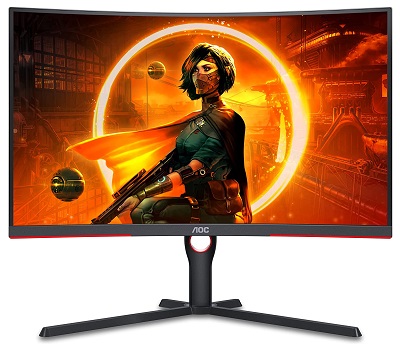
Features and aesthetics
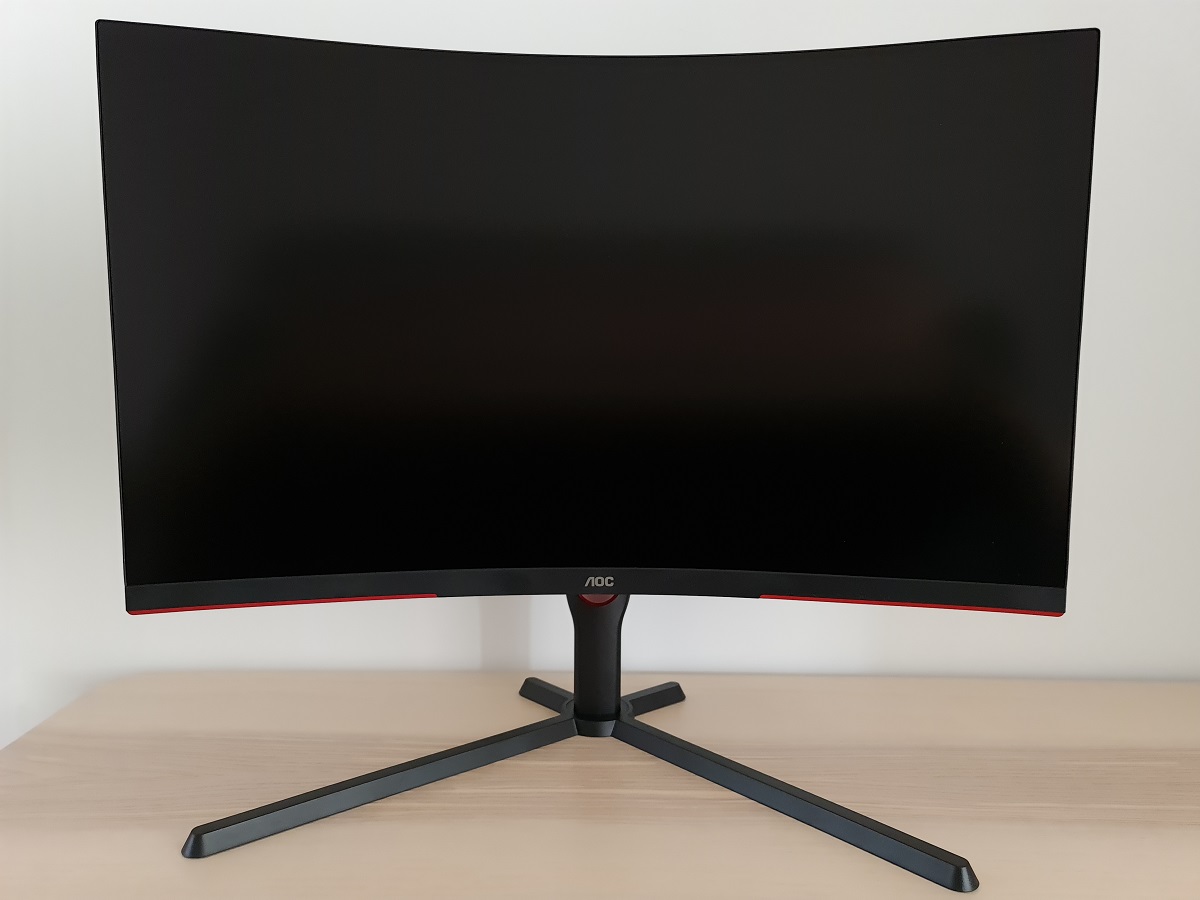

The OSD (On Screen Display) is controlled by buttons beneath the right side of the bottom bezel. A small front-facing power LED is located in this region. This glows cool white when the monitor is on and dark orange when it enters a low power state (system to the signal is lost). The video below explores this menu system and accompanying ‘G-Menu’ software.
From the side the screen is reasonably slender at thinnest point, ~11mm (0.43 inches). It lumps out centrally towards the stand attachment point. The ‘SE’ and ‘U’ models both offer tilt adjustment (5° forwards, 21.5° backwards). The ‘U’ model shown here also offers swivel (30° left, 30° right) and 130mm (5.12 inches) of height adjustment. The stand attaches to the screen via a quick-release mechanism and can be removed by pushing up a small latch beneath the attachment point. This reveals 100 x 100mm VESA holes for alternative mounting. At lowest stand height the bottom of the screen sits ~36mm (1.42 inches) above the desk surface, with the top of the screen ~459mm (18.07 inches) above the desk. The total depth of the monitor including stand is ~340mm (13.39 inches) with the centre of the screen ~135mm (5.13 inches) from the front edge of the stand. So a rather deep stand, due largely to the long front feet which eat up more desk space than is necessary. Though the screen itself can be placed reasonably close to the wall if you wish.
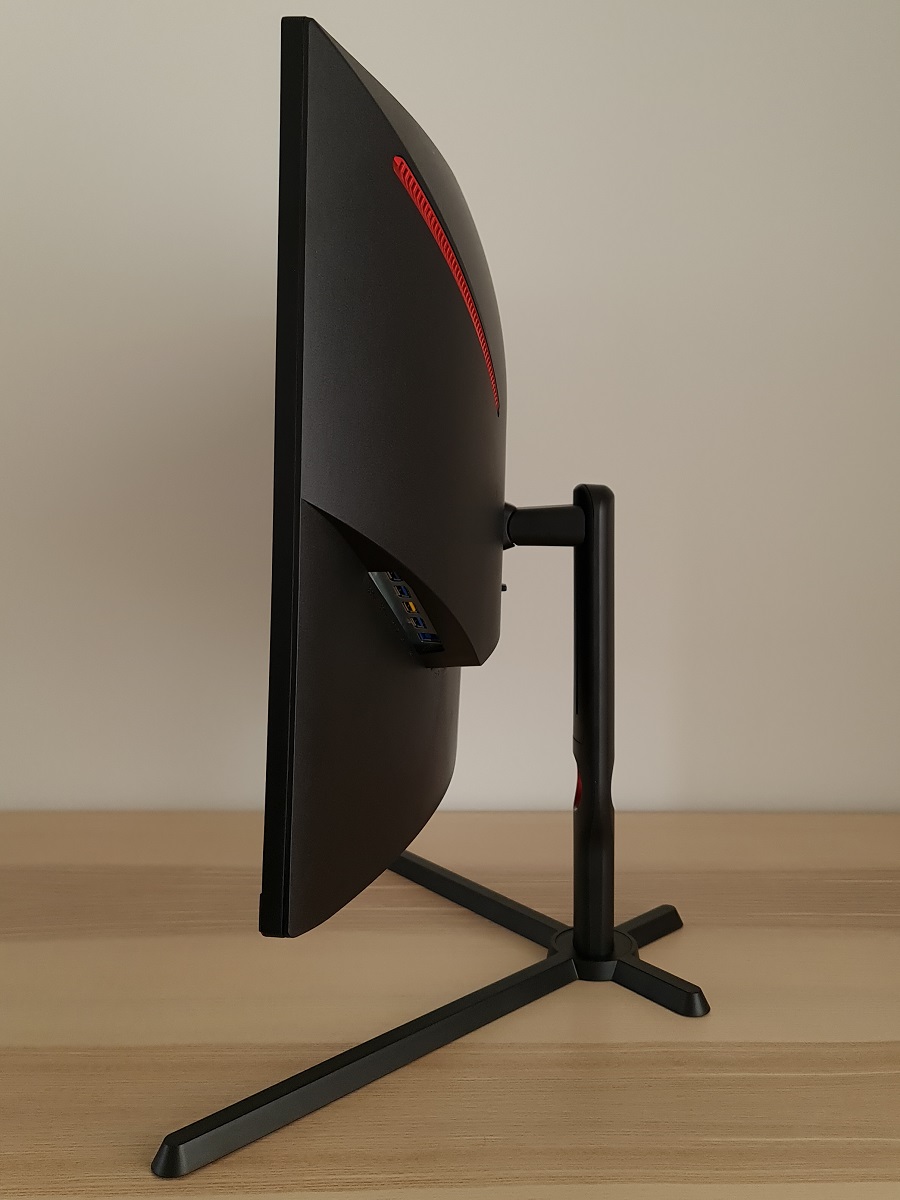
The rear of the monitor is mainly matte black plastic, with some interspersed dark red plastic ventilation elements for a bit of visual interest. The ports face downwards and include; 2 HDMI 2.0 ports, DP 1.4, 3.5mm headphone jack and AC power input (internal power converter). The ‘U’ model shown here also includes 4 USB 3.2 Gen1 ports (yellow-coloured port supports fast-charging) plus upstream. And includes 2 x 5W speakers beneath the dark red plastic elements towards the top of the screen, providing basic sound output. The volume is quite decent, but the sound output isn’t particularly rich and high quality – we don’t see these as a good replacement for even semi-decent standalone speakers or headphones. Just enough for basic audio needs. We also noticed a short ‘pop’ noise when the monitor was first switched on or regained a signal, so if you’re not using the monitor for audio we’d recommend turning the speakers off (‘Volume’ to ‘0’ in the ‘Extra’ section of the OSD).
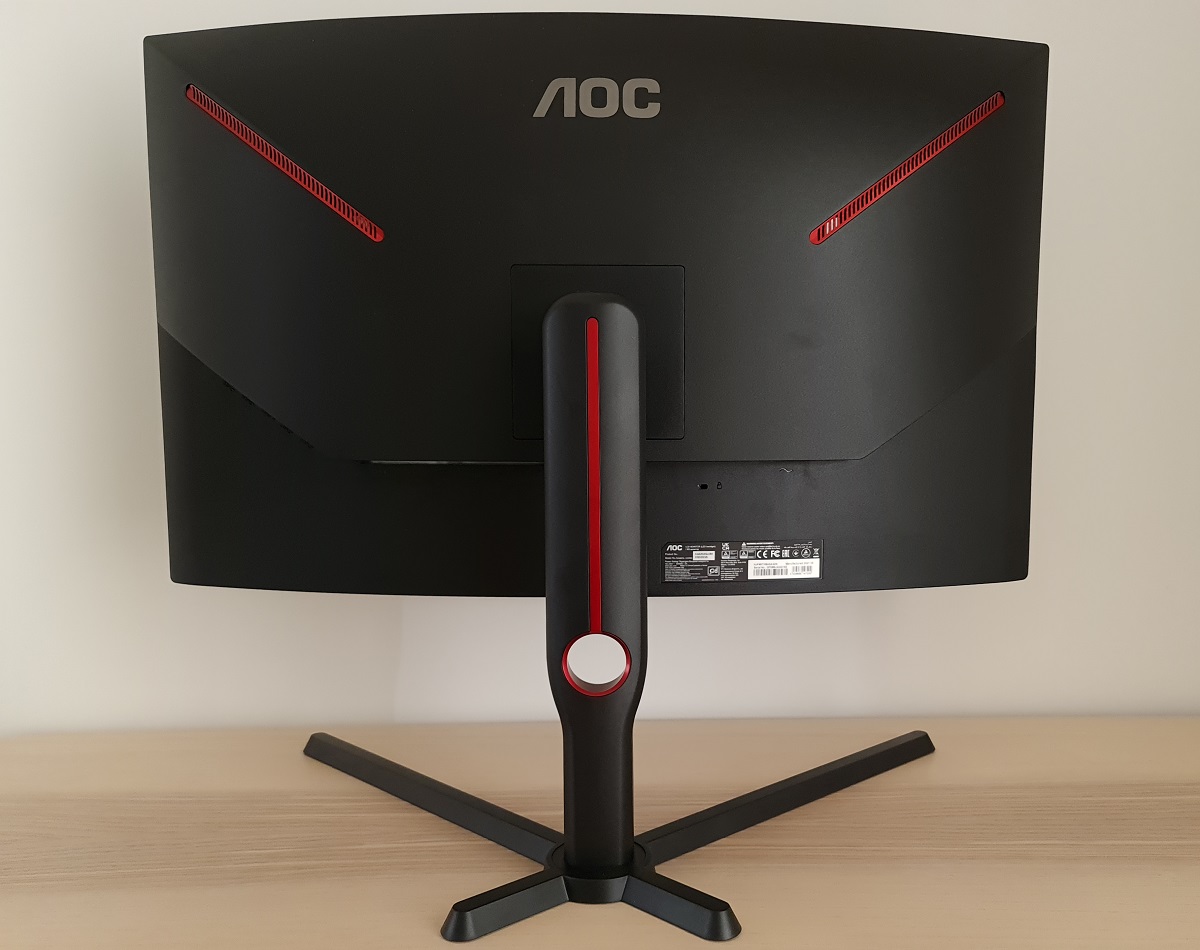
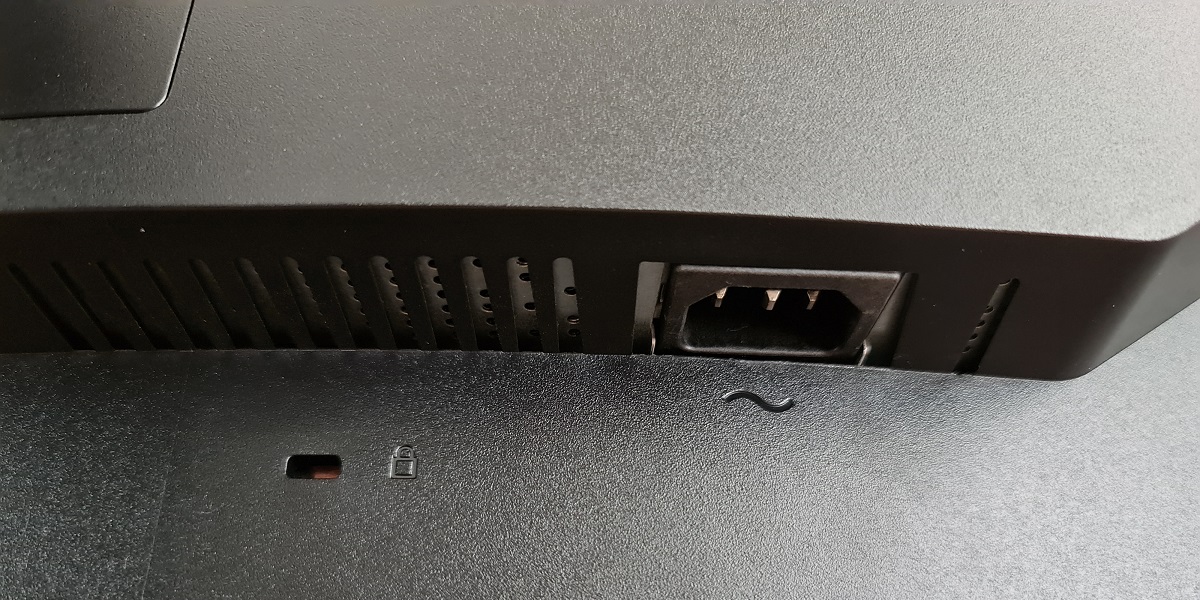
The full capability of the monitor including 2560 x 1440 @165Hz plus HDR and Adaptive-Sync can be leveraged via DP 1.4, including AMD FreeSync and Nvidia’s ‘G-SYNC Compatible Mode’. HDMI 2.0 is limited to 144Hz and supports AMD FreeSync but not Nvidia’s ‘G-SYNC Compatible Mode’. A power cable is included as standard, whilst additional cables such as DP and HDMI may be included in some regions. The image below shows the refresh rates supported for the native 2560 x 1440 (WQHD or 1440p) resolution via DP. The same refresh rates are listed via HDMI, except with a 144Hz maximum.
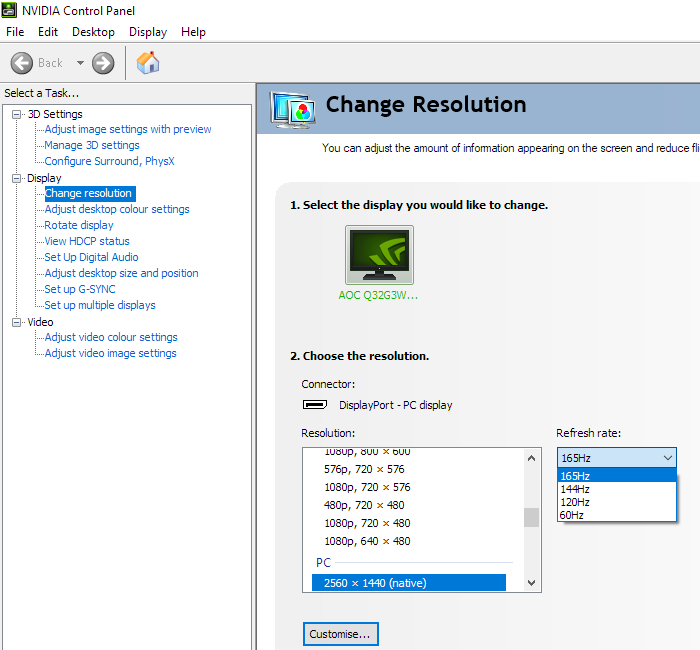
The images below show the refresh rates supported when running in the 1920 x 1080 (Full HD or 1080p) resolution using DP. The first image shows the resolutions categorised in the EDID of the monitor as ‘TV resolutions’ and listed here under ‘Ultra HD, HD, SD’. The second image shows resolutions categorised in the EDID and listed here as ‘PC’ resolutions. The same refresh rates are listed via HDMI for the first list, whilst the second list only includes 144Hz. A ‘4k x 2k, 3840 x 2160’ downsampling mode is also included when using HDMI at up to 60Hz, as shown in the third image. Potentially useful for games consoles that don’t support a 2560 x 1440 signal but would accept a 3840 x 2160 signal.
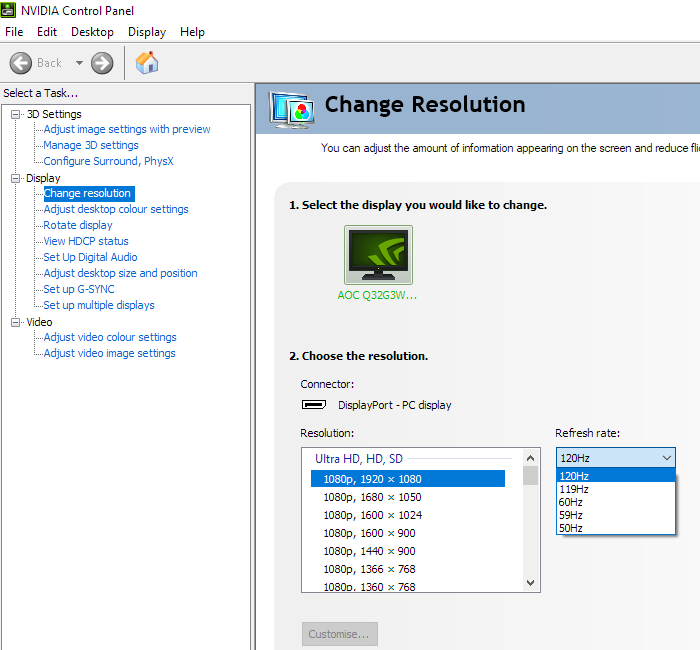
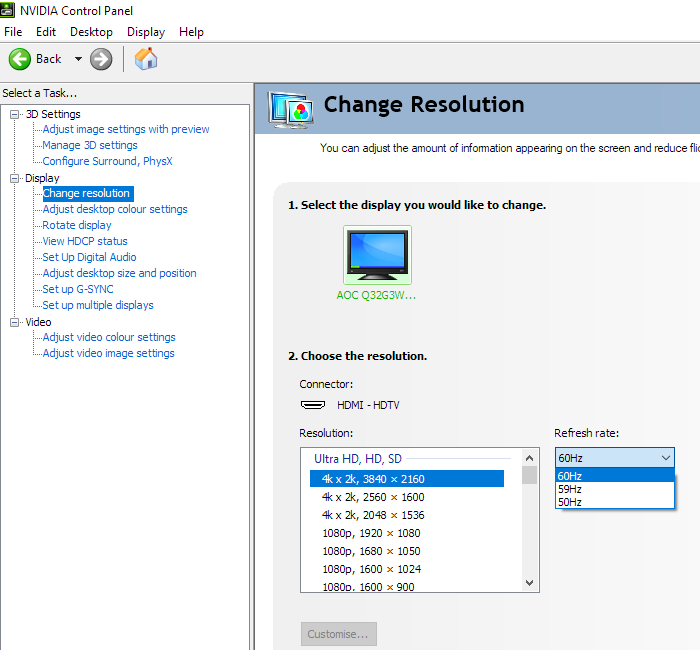
If you’re intending to use the monitor with the PS5 or Xbox Series X/S, be aware that a small settings tweak may be required to ensure 120Hz is selectable for supported resolutions. Details can be found in this article.
Calibration
Subpixel layout and screen surface
![]()
As shown above the standard RGB (Red, Green and Blue) stripe subpixel layout is used. This is the default expected by modern operating systems such as Microsoft Windows. Apple’s MacOS no longer uses subpixel rendering and therefore doesn’t optimise text for one particular subpixel layout to the detriment of another. You needn’t worry about text fringing from non-standard subpixel layouts and won’t need to change the defaults in the ‘ClearType Text Tuner’ as a Windows user. You may still wish to run through the ClearType wizard and adjust according to preferences, however. The subpixels are slightly squat as is often see on VA panels, though not to a huge degree in this case. The gaps above and below each subpixel are slightly thicker than they could be, which can lead to or exacerbate issues such as static ‘interlace pattern artifacts’ and make some text and fine edges appear slightly softer. As we explore later, we didn’t observe such artifacts on this model.
![]()
Testing the presets
Monitor Settings Gamma (central average) White point (kelvins) Notes Gamma1 (Factory Defaults) 2.2 6503K The image appears quite vibrant with impressively tuned white point. Though the green channel is a touch weak. Measured average gamma is good, but as usual for a VA panel there are some perceived gamma shifts. Causing saturation losses towards the bottom and sides of the screen from a normal viewing position. Gamma2 2.0 6472K As above but gamma reduced a bit, sapping some depth and vibrancy. Gamma3 2.4 6498K As factory defaults with increased gamma, providing a deeper look to things. Some dark detail masked as a result, more of a ‘cinematic’ look overall. Color Temp. User 2.2 7306K As factory defaults but somewhat brighter with a cool tint. Color Temp. sRGB 2.2 6511K An sRGB emulation mode, clamping the colour gamut close to sRGB with locked moderate brightness. Saturation levels are curtailed for more faithful sRGB output. Gamma averages ‘2.2’ but sRGB curve is followed, providing an uplift for dark shades. Some medium shades appear somewhat lighter with less depth than they should have, too. Many settings locked off including brightness, colour channels and gamma. LowBlue Mode = Multimedia 2.2 6271K A weak Low Blue Light (LBL) setting, slightly reducing blue channel and slightly reducing blue light output compared to factory defaults. LowBlue Mode = Internet 2.2 6057K As above but slightly more effective. LowBlue Mode = Office 2.2 5680K A moderately effective LBL setting. Green channel remains relatively strong, imparting a green tint which your eyes adjust to a bit over time. LowBlue Mode = Reading 2.2 5276K As above but stronger – an effective LBL setting which minimises the blue channel and reduced blue light output significantly compared to factory defaults. Test Settings (see below) 2.2 6519K A fairly vibrant and varied look to the image with good overall gamma and colour channel balance.
Straight from the box the monitor provided quite a vibrant image that was well-balanced in terms of gamma and white point, though the green channel was a touch weak. The image below shows the gamma curve under our ‘Test Settings’, which is very similar to the factory default gamma tracking. The gamma tracking isn’t quite as tight to the ‘2.2’ curve as it could be, but the central bowing and deviations elsewhere are only minor and the tracking is still decent overall. Given the intended uses for monitor, inter-unit variation and good performance following OSD tweaking alone we will not be using any ICC profiles for this review or including any measurements or graphs using them. We wouldn’t recommend using them unless created for your specific unit using your own calibration device. But we appreciate some users still like to use profiles and some aspects such as gamut mapping for colour-aware applications can be useful. You can download our ICC profile for this model, which was created using our ‘Test Settings’ as a base. You can also download our sRGB profile which was created using and designed for ‘Color Temp. = sRGB’ (sRGB emulation setting). This provided tracking of the standard ‘2.2’ gamma curve on our unit and made further corrections. Be aware of inter-unit variation and note again that these ICC profiles are not used in the review. Note again that this ICC profile is not used in the review. ‘LowBlue Mode’ Low Blue Light (LBL) settings also feature, located in the ‘Color Setup’ section of the OSD. From weakest to strongest effect these are; ‘Multimedia’, ‘Internet’, ‘Office’ and ‘Reading’. The ‘Reading’ setting offered a significant reduction in blue light output from the screen, with the effect further enhanced by further reducing the brightness level. Reducing exposure to blue light is particularly important in the hours leading up to sleep as blue light affects sleep hormones. Increasing alertness and making it more difficult for the body to shut off. As usual for LBL settings, the green channel remains relatively strong as reducing this significantly incurs a contrast penalty. This resulted in a green tint, which wasn’t extreme in this case and your eyes should adjust to a bit over time. We used the ’Reading’ setting with reduced brightness for our own viewing comfort in the evenings, although not for specific testing beyond that involving this particular setting. We would’ve liked to have seen a shortcut key or another method to quickly enable or disable this setting, but once you’re familiar with the menu layout (or if you use ‘G-Menu’ software) it’s quite easy to enable or disable the setting. For our ‘Test Settings’ we reduced brightness and made some colour channel adjustments. Note that individual units and preferences vary, so these settings are simply a suggestion and won’t be optimal for all users or units. We’ve also included our preferred ‘Overdrive’ setting used for most of the review and the refresh rate used in Windows, just for reference. These settings only apply to SDR, HDR has separate settings associated with it (is far more restrictive) and is explored in the relevant section of the review. Brightness= 72 (according to preferences and lighting) Color Temp.= User R= 50 G= 48 B= 41 Overdrive = Medium Adaptive-Sync= On Refresh rate (Windows setting)= 165Hz
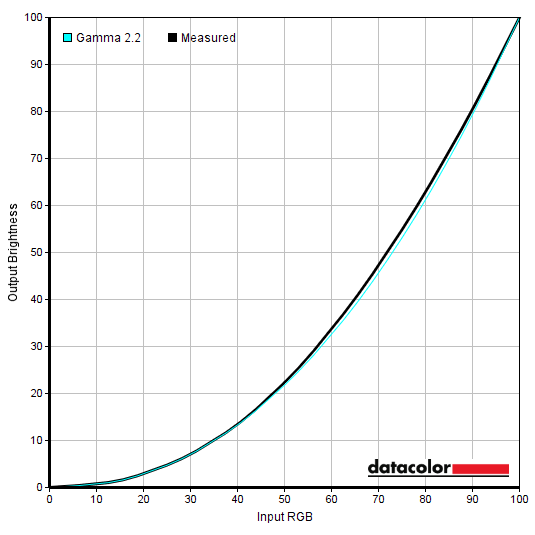
Gamma 'Test Settings'
Test Settings
Contrast and brightness
Contrast ratios
An X-Rite i1Display Pro Plus was used to measure the luminance of white and black using various settings, including those found in the calibration section. From these values, static contrast ratios were calculated. The table below shows these results, with blue highlights indicating the results with HDR active and under our ‘Test Settings’. Black highlights indicate the highest white luminance, lowest black luminance and highest contrast ratio recorded (MBR deactivated). Assume any setting not mentioned was left at default, with the exceptions already noted here or in the calibration section.
Measurements using ‘MBR’ were taken at 165Hz, as with other measurements – brightness levels were similar at lower refresh rates, so we didn’t feel it was worthwhile documenting these observations on the table.
| Monitor Settings | White luminance (cd/m²) | Black luminance (cd/m²) | Contrast ratio (x:1) |
| 100% brightness | 321 | 0.16 | 2006 |
| 80% brightness | 176 | 0.09 | 1956 |
| 60% brightness | 145 | 0.07 | 2071 |
| 40% brightness | 115 | 0.06 | 1917 |
| 20% brightness | 83 | 0.04 | 2075 |
| 0% brightness | 50 | <0.03 | >1667 |
| DisplayHDR* | 321 | 0.13 | 2469 |
| HDR Picture* | 320 | 0.13 | 2462 |
| HDR Movie* | 320 | 0.13 | 2462 |
| HDR Game* | 320 | 0.13 | 2462 |
| Gamma1 (90% brightness, Factory Defaults) | 194 | 0.10 | 1940 |
| Gamma2 | 193 | 0.10 | 1930 |
| Gamma3 | 193 | 0.10 | 1930 |
| Low Blue Mode = Multimedia | 193 | 0.10 | 1930 |
| Low Blue Mode = Internet | 192 | 0.10 | 1920 |
| Low Blue Mode = Office | 190 | 0.10 | 1900 |
| Low Blue Mode = Reading | 188 | 0.10 | 1880 |
| Color Temp. = User | 212 | 0.10 | 2120 |
| Color Temp. = User (100% brightness) | 353 | 0.16 | 2206 |
| Color Temp. = sRGB | 192 | 0.10 | 1920 |
| MBR = 1 | 241 | 0.12 | 2008 |
| MBR = 10 | 167 | 0.08 | 2088 |
| MBR = 20 | 87 | 0.04 | 2175 |
| Test Settings | 170 | 0.08 | 2125 |
*HDR measurements were made using this YouTube HDR brightness test video, running full screen at ‘1440p HDR’ on Google Chrome. The maximum reading from the smallest patch size (measurement area) that comfortably covered the entire sensor area and colorimeter housing was used for the white luminance measurement, which was ‘4% of all pixels’ in this case. The black luminance was taken at the same point of the video with the colorimeter offset to the side of the white test patch, equidistant between the test patch and edge of the monitor bezel.
The average static contrast with only brightness adjusted was 2005:1, excluding the value at ‘0% brightness’, where the black point rounding throws off accuracy too much. This is some way shy of the specified 3000:1 but still firmly within VA territory. The peak contrast recorded under SDR was 2206:1, with colour channels set to their neutral position (‘Color Temp. = User) and full brightness. We recorded 2125:1 following the adjustments made to our ‘Test Settings’, which is relatively strong by general LCD standards but not as strong as some VA models. The monitor does not provide local dimming and therefore provides no contrast advantage under HDR. The somewhat higher contrast recorded (up to 2469:1) with HDR active is simply due to the adjusted measurement point used for measure black point, where brightness levels were lower due to the uniformity of our unit. The peak luminance recorded under HDR was 320 – 321 cd/m², so no luminance advantage compared to SDR and low by HDR standards. Sustained luminance levels were similar to this and were not documented. Considering SDR measurements, the maximum luminance recorded was 353 cd/m² whilst the minimum white luminance recorded was 50 cd/m². This provides a 303 cd/m² luminance adjustment range with a reasonably bright maximum and reasonably low minimum.
The monitor includes a Dynamic Contrast setting called ‘DCR’ (Dynamic Contrast Ratio). This blocks off the brightness control (and others such as ‘Contrast’ and ‘Gamma’) and makes adjustments based on the scene. The backlight adjusts at a fairly gradual pace to changes in the average light or dark in a scene. It dimmed fairly effectively for predominantly dark content, but tended towards a rather high brightness for mixed content including a good number of intertwining dark elements. As usual this setting is a compromise and adjusts the entire backlight as a single unit, so can’t account for the mixtures of light and dark that occur in most scenes. As usual we prefer manual control of brightness over this sort of Dynamic Contrast setting. It can make some sense under HDR where the alternative is very high backlight brightness, which saps depth from darker content – but it can’t be activated under HDR and no alternative is used there, either.
PWM (Pulse Width Modulation)
The CQ32G3SU does not use PWM (Pulse Width Modulation) to regulate backlight brightness at any level. Instead, DC (Direct Current) is used to moderate brightness. The backlight is therefore considered ‘flicker-free’, which will come as welcome news to those sensitive to flickering or worried about side-effects from PWM usage. The exception to this is with ‘MBR’ active, a strobe backlight setting which causes the backlight to flicker at a frequency matching the refresh rate of the display.
Luminance uniformity
Whilst observing a black background in a dark room, using our ‘Test Settings’, we noticed a moderate amount of backlight bleed and clouding, particularly towards the bottom of the screen where it appeared as quite distinct ‘spots’. It’s important to remember that individual units vary when it comes to all aspects of uniformity, including backlight bleed and clouding. The following image was taken a few metres back to eliminate ‘VA glow’. This is a silverish to purple glow that appears towards the edges, particularly near the bottom of the screen from a normal viewing position. This ‘VA glow’ blooms out more noticeably from sharper angles, as demonstrated in the viewing angles video later on. The luminance uniformity was variable. The maximum luminance was recorded at ‘quadrant 3’ towards the top right of the screen (172.8 cd/m²). The greatest deviation from this occurred at ‘quadrant 4’ to the left of centre (149.4 cd/m², which is 14% dimmer). The average deviation between each quadrant and the brightest recorded point was 8.38%, which is reasonable. Note that individual units vary when it comes to uniformity and you can expect further deviation beyond the points measured. For example, our unit had a localised darker patch towards the bottom right that that wasn’t accounted by these measurements. It can be seen in the Lagom text photograph later on with a light grey background, however. The contour map below shows these deviations graphically, with darker greys representing lower luminance (greater deviation from brightest point) than lighter greys. The percentage deviation between each quadrant and the brightest point recorded is also given. The SpyderX Elite was also used to analyse variation in the colour temperature (white point) for the same 9 quadrants. The deviation between each quadrant and the quadrant closest to the 6500K (D65) daylight white point target was analysed and a DeltaE value assigned. Darker shades are also used on this map to represent greater deviation from 6500K. A DeltaE >3 represents significant deviation that may be readily noticed by eye. The colour temperature deviation was moderate, with significant deviation recorded towards the top left (DeltaE 3.2) and more so to the right of centre (DeltaE 3.9). Note again that individual units vary when it comes to uniformity and that you can expect deviation beyond the measured points. Also be aware that there are some perceived deviations in both brightness and colour temperature that are typical on VA panels and aren’t reflected by these readings. In addition to the quantitative testing above, we performed a subjective assessment of the uniformity of a variety of ‘medium’ shades, including 50% grey. Some monitors exhibit uniformity issues such as splotches or striations when viewing screen fills of such shades, giving an inconsistent appearance that some users refer to as ‘DSE’ (‘Dirty Screen Effect’). VA models are particularly prone to this. We observed slight patchiness in some regions of the screen but no clear striations. There were no obvious issues such as heavy patchiness or clear striations, except for a darker spot towards the bottom right which was more of a conventional uniformity issue rather than ‘DSE’ related, specifically. The monitor put in a relatively strong contrast performance on Battlefield V. At a static contrast of ~2125:1 under our ‘Test Settings’, the monitor provided a relatively good atmosphere to darker scenes although not as impressive as some VA models. Dingy building interiors and shaded areas reflected this relatively strong contrast, as did shadow detail in general – with some relatively deep dark shades aiding definition a bit there. There was ‘VA glow’ which was most noticeable from a normal viewing position towards the bottom of the screen but can also be observed near the top, depending on viewing position. This lightened up darker shades and ate away at the atmosphere somewhat, but not to the extent of your typical ‘IPS glow’. This glow is brought out more by a higher brightness setting, if you’re sitting closer to the screen or if your unit has significant backlight bleed or clouding. Our unit did have moderate clouding which brought this out a bit more. We also observed ‘black crush’, whereby dark shades other than black appear even deeper than intended and blend into a dark mass. Perceived gamma is higher than it should be, in other words. This wasn’t as pronounced as we’ve seen on some VA models. It occurs for the central region of the screen or wherever your eyes are directly in line with. Further out, detail levels are improved – and at the extreme peripheral regions and particularly lower down from our regular viewing position, some excess detail was observed due to perceived gamma being a bit low there. This was not extreme from our preferred viewing distance of ~70cm or a bit further back, but could still be noticed to a degree. Bright content stood out nicely against darker surroundings, whilst the relatively smooth finish of the screen surface was free from any real graininess. Our experiences were similar on Shadow of the Tomb Raider. This title craves a strong contrast performance, with plenty of dark passageways, dim interior locations and suchlike illuminated by a few point sources of light. The relatively strong static contrast of this model helped lift it above competing non-VA LCDs in terms of the depth and atmosphere provided here. There was some ‘VA glow’ to contend with, although not an extreme amount. The screen was certainly not OLED-like in terms of how ‘deep and inky’ things appear, particularly in a dimly lit room, but improved compared to other LCD panel types without very complex local dimming solutions in use. Shadow details such as cracks in rocks or shaded vegetation were also better defined due to the improved depth and contrast. Although ‘black crush’ was again present, so distinctions between closely matching dark shades weren’t as good as they could’ve been centrally. In contrast, some excess detail was revealed peripherally and in particular further down the screen – nothing extreme, but still observable and difficult to avoid on a VA model of this size. Brighter elements stood out nicely against darker surroundings. The screen surface again kept lighter shades free from clear graininess. We also observed contrast on the film Star Wars: The Rise of Skywalker. This title has a lot of high contrast scenes, with bright pulses or energy and suchlike lighting up dark surroundings. ‘VA glow’ was again observed, though the relatively strong contrast was still something we enjoyed on this title. Things didn’t appear super deep and cinematic in an OLED-like way nor was the model up there with the best VA performers in that respect. Nor did things appear as they might on an LCD model with a huge number of dimming zones – but the depth and atmosphere was still decent. In a moderately bright or dim room we could appreciate this edge compared to your typical IPS or TN model. In other words; the 2125:1 static contrast ratio may not be spectacularly high, but it’s still around twice as high as your typical IPS model. ‘Black crush’ was also observed as was the slight excess of dark detail revealed towards the bottom and side edges in particular. This can bring out ‘compression artifacts’ on streamed content and give a slightly ‘banded’ or ‘blocky’ appearance, but in this case things weren’t too extreme in that respect from our preferred viewing position. This excessive detail is more pronounced if sitting closer to the screen, however. The Lagom tests for contrast allow specific weaknesses in contrast performance to be identified. The following observations were made in a dark room. The CQ32G3SU’s colour gamut (red triangle) was compared with the sRGB (green triangle) and DCI-P3 (blue triangle) reference colour spaces using our ‘Test Settings’, as shown below. The gamut fully covers sRGB with some extension beyond – we recorded 90% DCI-P3 coverage. Although not shown in the graphic, we recorded 84% Adobe RGB coverage. For standard sRGB content outside a colour-managed environment things are represented with a dose of extra vibrancy and saturation, but not to an extreme degree. The monitor also offers an sRGB emulation setting – switching ‘Color Temp.’ to ‘sRGB’ in the ‘Color Setup’ section of the OSD. This clamps the colour gamut closer to sRGB and as explored previously you can’t adjust brightness – it’s locked to a moderate level (192 cd/m² recorded). Various other settings are locked off, including ‘Gamma’ and colour channels. Using this setting we recorded excellent sRGB coverage (99%) with just a sliver of over-extension for the red to blue edge. This setting is useful for more faithful representation of content within the sRGB colour space even in non colour-managed applications and without profiling of the monitor. Although lack of flexibility with OSD settings, including brightness, isn’t ideal. To maximise colour accuracy within the sRGB colour space, for colour-managed workflows, full calibration and profiling with a colorimeter or similar device using the full native gamut is recommended. You may try the ICC profile featured in the calibration section which includes gamut mapping for colour-aware applications, but best results are always obtained by calibrating your own unit with your own hardware. Instead of setting ‘Color Temp.’ to ‘sRGB’ and putting up with the restrictions associated with that, AMD users can activate a more flexible sRGB emulation setting with superior sRGB coverage and flexibility. This is done by opening ‘AMD Radeon Software’, clicking ‘Settings’ (cog icon towards top right) and clicking on ‘Display’. You should then ensure that the ‘Custom Color’ slider to the right is set to ‘Enabled’ and ‘Color Temperature Control’ set to ‘Disabled’. It may appear to be set this way by default, but the native rather than restricted gamut is likely in play. If that’s the case, simply switch the ‘Color Temperature Control’ slider to ‘Enabled’ then back to ‘Disabled’ to leverage the sRGB emulation behaviour. This setting is shown in the image below. The gamut below shows results using our ‘Test Settings’ with this driver tweak applied. The colour gamut covers 100% sRGB with just a touch of extension beyond in places. This setting offers decent tracking of sRGB and helps to cut down on the colour gamut without profiling, including in applications that aren’t colour managed. It offers marginally more complete coverage than the sRGB emulation setting did on our unit, too. Although it also has slightly more over-extension compared to the sRGB emulation setting of the monitor. The gamut differences here aren’t dramatic comparing the two, however. And you don’t have to put up with restrictions associated with the monitor’s sRGB emulation setting. Remember not to use this tweak under HDR, though, or the image will appear significantly oversaturated. The monitor outputted shades in quite a vibrant way on Battlefield V. Most content you consume is designed with the sRGB colour space in mind, including games like this running under SDR. If the colour gamut of the monitor extends beyond sRGB, as it does in this case, extra saturation and vibrancy is invited. Unlike a digital saturation boost, such as changing the ‘GameColor’ section in the OSD, appropriate shade variety is maintained. Digital saturation boosts pull shades closer to the edge of the gamut without expanding the gamut, crushing things together without improving the upper end of saturation. The environments in this game appeared a bit more vivid than intended overall, with some greens having their yellow components brought out too strongly. And rich reddish browns verging a bit too much on red – with a bit of extra vividness to sky blues thrown into the mix, too. This also gave quite a vivid look to elements such as fires and brightly painted objects. Particularly rich reds which appeared quite striking and somewhat neon. Overall, though, the extra saturation wasn’t as extreme as on some wide gamut models. As the gamut in this case is reasonably tame in comparison. We made similar observations on Shadow of the Tomb Raider. The overall look was quite vivid, with extra saturation in places. On both game titles we observed a loss of saturation or some shades appearing slightly duller peripherally, particularly further down and towards the extreme side edges. This is due to reduced perceived gamma here, as typical for VA models. A degree of this is inescapable on a screen as large as this and is more pronounced if you’re sitting closer to the screen. From our preferred viewing position (~70cm or a bit further back) this wasn’t extreme by any means and about as low as we’ve seen on a VA model. Which is quite impressive given the size of the screen. Lara Croft’s skin for example appeared a bit oversaturated (slightly too tanned or reddish) if displayed centrally, but became more appropriately saturated a bit further out and a bit undersaturated towards the extreme peripheral regions of the screen. For those who prefer to tone down saturation, the ‘sRGB’ setting of the monitor can be useful. The brightness lock is an annoying restriction, though, so an alternative method of sRGB emulation may be preferred. The idea of colour consistency was further explored using various episodes of the TV series Futurama. With large areas of individual shade, this is a particularly brutal test for colour consistency. The fairly vibrant colour output of the monitor was again apparent here, with neon shades such as bright greens and bright cherry reds presented with eye-catching ‘pop’. This was particularly true where they were set against a darker background, with the strong contrast also coming into play. Pastel shades tended to appear a touch oversaturated (but not to an extreme degree) centrally, whilst losing saturation peripherally and ultimately looking a touch undersaturated or somewhat duller than they should at the extreme edges of the screen. Particularly the bottom and side edges from our preferred viewing position. The saturation shifts here were lower than we’d typically see from a VA model but more pronounced than with your typical IPS-type panel. The image below shows a printed reference sheet of 24 ‘sRGB’ shades, included as part of the Datacolor SpyderCHECKR 24 package. The screen is displaying reference photographs of this printed sheet, in both the same order as printed (right side) and reverse order (left side). The camera is mounted slightly above centre so that the image is representative of what the eye sees from an ergonomically correct viewing position. This, coupled with the inclusion of a flipped version of the shade sheet, allows both accuracy and colour consistency to be visually assessed. Bracketed numbers in our analysis refer to shades on the printed sheet or right side of the screen if they’re ordered consecutively from top left to bottom right. Note that there is always some disparity between how emissive objects (monitor) and non-emissive objects (printed sheet) appear. The representation of shades in this image depends on the camera and your own screen, it’s not designed to show exactly how the shades appear in person. It still helps demonstrate some of the relative differences between the original intended sRGB shade and what the monitor outputs, however. Full profiling and appropriate colour management on the application would provide a tighter match, our intention here is to show what can be expected in a non colour-managed environment. Light chocolate brown (24) is displayed with an overly strong red hue due to the colour gamut, more so when displayed towards the top vs. bottom of the screen. Peach pink (20) also shows a red push. Candy apple red (14) appears a rather striking and somewhat neon version of the intended shade, with dark lime green (18) and yellow green (19) also showing a bit of a neon push. This was a touch stronger further up the screen (more in line with your eye) than lower down. Medium orange (3) and aquamarine (4) are presented quite well, with a bit of saturation lost further down the screen but not as much as we’d typically observe on a VA model. Black (21) is interesting to observe as it highlights some of the perceived gamma shifts. The photograph shown on the screen is of the actual printed sheet, which has a slight material texture to it. This is well-blended and barely visible when viewed on most of the screen, but it’s more visible lower down the screen (or towards the sides) due to the aforementioned perceived gamma shifts. This is clearer by eye than in the photo. As explored earlier, the monitor includes an sRGB emulation mode. But it’s very limited in its practicality due to the brightness being locked at a moderately high level and general lack of flexibility. The comparison between printed sheet and the screen is massively skewed and captured poorly if a high monitor brightness is used, so we won’t be including any photos using this setting and the SpyderCHECKR 24 test. As usual, we’d recommend profiling the monitor with your own colorimeter or spectrophotometer using the native gamut if you require the strongest level of colour accuracy. Lagom’s viewing angle tests help explore the idea of colour consistency and viewing angle performance. The following observations were made from a normal viewing position, eyes ~70cm from the screen. The shifts observed are more readily apparent if sitting closer and less apparent if sitting further away. On some monitors, particularly but not exclusively those with high refresh rates, interlace patterns can be seen during certain transitions. We refer to these as ‘interlace pattern artifacts’ but some users refer to them as ‘inversion artifacts’ and others as ‘scan lines’. They may appear as an interference pattern, mesh or interlaced lines which break up a given shade into a darker and lighter version of what is intended. They often catch the eye due to their dynamic nature, on models where they manifest themselves in this way. Alternatively, static interlace patterns may be seen with some shades appearing as faint horizontal or vertical bands of a slightly lighter and slightly darker version of the intended shade. We did not observe static interlace patterns, but we did observe dynamic interlace pattern artifacts. These manifested as very thin vertical interlaced lines, observable during movement on the screen or when scanning our eyes across the screen in a certain way. Particularly for lighter shades. They were relatively faint at higher refresh rates but became more noticeable at reduced refresh rates. Particularly as things dropped much below 100Hz – below 80Hz we noticed them even when observing static content and moving our eyes just slightly. Not everyone will notice these, but sensitive users may find them bothersome. A small utility called SMTT 2.0 was used alongside a sensitive camera to analyse the latency of the CQ32G3SU, with over 30 repeat readings taken to help maximise accuracy. Using this method and Adaptive-Sync enabled in the driver and OSD, we calculated 3.63ms (over ½ a frame at 165Hz) of input lag. At 60Hz we measured a marginally higher but still respectable 4.38ms. Similar results were recorded with Adaptive-Sync disabled and ‘Low Input Lag’ enabled instead. The input lag measured here is influenced by both the element you ‘see’ (pixel responsiveness) and the main element you ‘feel’ (signal delay). It indicates a low signal delay which most users should find acceptable. Note that we don’t have the means to accurately measure input lag with Adaptive-Sync active in a VRR environment or with HDR active in an HDR environment. Our article on responsiveness explores various key concepts related to monitor responsiveness. Chief amongst these is the idea of perceived blur, contributed to by both the movement of your eyes as you track motion on the screen and pixel responsiveness. Eye movement is the dominant cause of perceived blur on modern monitors, but both factors play an important part. We also explore ‘pursuit photography’, using a moving camera to capture motion on a screen in a way which reflects both elements of perceived blur. Compared to static photography or videos, which only reflect weaknesses in pixel responsiveness. The images below are pursuit photographs taken using the UFO Motion Test for ghosting, with the UFO moving across the screen from left to right at a frame rate matching the refresh rate of the display. The test is set to run at its default speed of 960 pixels per second, which is a practical speed for such photographs and sufficient to highlight weaknesses. The monitor was tested at 60Hz (directly below), 120Hz and 165Hz. Although 144Hz was not documented here, it was tested and performed some way between 120Hz and 165Hz as you might expect. The main ‘Overdrive’ response time settings were tested; ‘Off’, ‘Weak’, ‘Medium’ and ‘Strong’. All rows of the UFO Motion Test were used, highlighting a range of pixel transitions between various shades. The final columns show some reference screens for comparison, where possible, using what we deem to be their optimal pixel response time settings. The first reference screen is the Gigabyte G32QC, another 165Hz VA model with similar panel technology. And the Gigabyte M27Q, a moderately fast IPS model. According to test data from other reviewers, it’s possible the ‘SE’ model has different pixel overdrive tuning. Generally more aggressive (more overshoot) at reduced refresh rates using the ‘Medium’ setting compared to the ‘SU’ tested here.. As well as increasing refresh rate to minimise perceived blur due to eye movement, the monitor offers an alternative in the form of ‘MBR’ (Motion Blur Reduction). This is a strobe backlight setting that causes the backlight to pulse at a frequency matching the refresh rate of the display – 120Hz, 144Hz or 165Hz. Sensitivity to this flickering varies and some may find it bothersome whilst others will notice accelerated eye fatigue when using the setting, even if the flickering isn’t actively bothersome to them. The pursuit photographs below were taken with the monitor set to 120Hz using MBR. A few reference screens are also shown for comparison, using their respective strobe backlight settings at 120Hz. The AOC C24G1 using MBR (Motion Blur Reduction) and set to what we consider its optimal setting for that. And the Dell S2417DG using ULMB (‘Ultra Low Motion Blur’). Note that the ‘Overdrive’ setting can be adjusted under MBR. We’ll only test ‘Strong’ here as anything lower was simply too slow for a reasonable performance with MBR active. Also be aware that a ‘Boost’ overdrive setting is available which is equivalent to setting ‘MBR’ to ‘20’ and ‘Overdrive’ to ‘Strong’. With MBR active at 120Hz, above, the main object appears significantly narrower with clearer internal detailing. This is at least true for ‘MBR = 10’ and moreover ‘MBR = 20’. The white notches can be counted using ‘MBR = 20’ and in practice the segments of the UFO can be counted – not super distinct, but not completely blended into the red UFO body as shown here. This more focused look to the object with more distinct definition indicates a significant decrease in perceived blur due to eye movement, the main goal of a strobe backlight setting such as this. Some trailing is visible behind and in some cases in front of the object, fragmented due to the strobe nature of the backlight. The all-encompassing term ‘strobe crosstalk’ is used to describe this fragmented trailing around the object. Because not all areas of the screen refresh simultaneously, the appearance of strobe crosstalk can differ depending on how high up or low down on the screen the movement is being observed. There is also some overshoot mixed in, though the strobe crosstalk sometimes overlaps this so it isn’t clearly visible. You can see a magenta to red fringe directly behind the UFO body, clearest at a higher MBR setting. This is due to the slow decay of the red KSF phosphors used for the backlight and is very commonly observed with strobe backlight modes on wide gamut models. The reference screens are standard gamut screens and don’t show this – they also show quite distinct overshoot with little to no strobe crosstalk for the images shown. The images below show results with MBR active at 165Hz. 144Hz was also observed though not documented and performed some way between 120Hz and 165Hz, as you might expect. The clarity of the initial object has been somewhat improved, particularly for ‘MBR = 20′. The segmentation is again more distinct by eye than it appears here for ‘MBR = 20’, though the black lines still blend in a bit more than they could. Due to the increase in refresh rate, the fragments are smaller but there are a greater number of them and each fragment is more distinct. Behind the red UFO body the strobe crosstalk is strong enough so that it essentially melds into one object and makes the object appear more extended than it should be, particularly for the medium background. Note the 2 additional white dots visible on the left side, due to the overlap. Some overshoot is visible for the further out fragments, where it isn’t masked by strobe crosstalk. As noted just before, it’s important to note that strobe crosstalk varies at different areas of the screen. Not all areas refresh simultaneously, so its appearance can differ depending on how high up or low down on the screen movement is being observed. The images below show pursuit photographs running from the top to bottom regions of the screen, with the screen set to 120Hz, ‘Overdrive = Strong’ and ‘MBR = 20’ (‘Boost’ also achieves this). Strobe crosstalk variation at different points of the screen was similar at lower MBR settings so we didn’t feel it was worthwhile documenting these observations. Note that these images are designed to show strobe crosstalk behaviour and don’t accurately show how distinct details on the main object appear. Further up the screen you can see overshoot behind the object and some strobe crosstalk in front – not an extreme amount. The strobe crosstalk soon disappears and overshoot diminishes somewhat a bit lower down. Centrally, a bit of strobe crosstalk overlapping overshoot is visible – both significantly fainter than the object itself. A little below centre the strobe crosstalk starts strengthening a bit and covers the overshoot. Overall, strobe crosstalk levels are not extreme for the central bands of the screen for the transitions shown here. That’s good to see here as that’s where you mainly focus when playing games that mostly benefit from such a setting, for example fast-paced FPS games. Strong strobe crosstalk is visible behind the object lower down the screen. Below you can see how things look at 165Hz with ‘MBR = 20’ and ‘Overdrive = Strong’. The overshoot is lower and strobe crosstalk stronger now. Centrally, the strobe crosstalk is a fair bit bolder than at 120Hz and a bit below centre is nearly as bold as the object itself. Further down the screen a distinct repetition of the object is visible due to the strobe crosstalk being just as bold as the object. As we explore subjectively later, we found the strobe crosstalk a bit overbearing at 165Hz and preferred 120Hz. 144Hz is again some way between these, so we still preferred the reduced strobe crosstalk at 120Hz. On Battlefield V, with frame rates keeping pace with the refresh rate, the monitor provided quite a fluid 165Hz experience. The monitor is pumping out up to 2.75 times as much visual information every second as a 60Hz monitor (or this monitor running at 60Hz). This high refresh rate and frame rate combination improves ‘connected feel’, which describes the precision and fluidity felt when interacting with the game. This is also aided by low input lag and in particular a low signal delay, which this model delivers. There’s also a reduction in perceived blur due to eye movement, as demonstrated earlier using Test UFO. The increase from 144Hz to 165Hz is not substantial and certainly isn’t as clear as the initial boost from 60Hz to 120Hz+, but the 165Hz refresh rate still provides a bit of an edge at a suitable frame rate. Another important component of perceived blur is pixel responsiveness, which is the common downfall of VA models. This one was no exception there as there were some distinct weaknesses – this was again highlighted earlier, using Test UFO. The most significant weaknesses occur where dark shades are involved in the transition, with a ‘smeary’ appearance to the trailing in places. This is sometimes accompanied by a leaching out of some of the colours contained within the dark shade, such as blue, cyan or dark red. These distinct weaknesses can also manifest as a ‘flickering’ effect, as mixtures of dark and somewhat lighter shades will see the somewhat lighter shades become darker during movement so they move into the black background. And return to normal when the movement ceases. Overall, these weaknesses were not as extensive or as pronounced as we’ve seen on some VA models. Including the Gigabyte G32QC we tested, with the comparison drawn earlier. But there’s still a gulf when compared to even a reasonable IPS-type performer of this sort of refresh rate. There was little to complain about in the way of overshoot, though, with just some traces here and there but nothing we found at all eye-catching. The section of the video review below demonstrates some of these weaknesses. We made similar observations on Shadow of the Tomb Raider. An edge was again given in terms of ‘connected feel’ and reduced perceived blur from the high frame and refresh rate combination. Though the competitive edge here is less important for such ‘casual gaming’, it’s still a nice bonus. There were similar weaknesses observed, most pronounced where darker shades were involved. Something that is rather common on this title. The ‘smeary’ trailing was again quite pronounced for some transitions, though not as widespread or as extensive as on some VA models. Quite a few transitions were performed at moderate but not particularly fast or slow speed, giving a bit of a mask of extra overall perceived blur without this distinct ‘smeary’ appearance. There was little to complain about in the way of overshoot. Overall, some casual gamers will find these weaknesses tolerable, but it’s ultimately very subjective. We also observed video content of a range of frame rates. Including ~24-30fps and 60fps content on platforms such as Netflix and YouTube. There were some touches of ‘smeary’ trailing for the 60fps content, but the weaknesses were less pronounced than for the higher frame rate game content. For the ~24-30fps content just a few underlying weaknesses were present. Some slightly extended trailing we’d describe as ‘heavy powdery’ trailing was observed, but not extending far enough back from the object or bold enough to have a distinct ‘smeary’ appearance. The pixel response requirements for a good performance are greatly reduced at these low frame rates, so they’re much more forgiving in that respect. As an Amazon Associate I earn from qualifying purchases made using the below link. Where possible, you’ll be redirected to your nearest store. Further information on supporting our work. Earlier in the review, we introduced the ‘MBR’ (Motion Blur Reduction) feature, its principles of operation and how it performs using specific tests. When using MBR or a similar strobe backlight feature, you must have your frame rate synchronised properly with the refresh rate of the display. If that isn’t the case you’re left with extremely obvious stuttering or juddering. This stands out in a particularly obvious way because there’s very little perceived blur due to eye movement to mask it. You can’t use Adaptive-Sync at the same time as MBR. We tested this setting using various game titles, but as usual we’ll just focus on Battlefield V for this section, running solidly at a frame rate matching the refresh rate of the display. As covered earlier, the best clarity is obtained with ‘MBR’ set to ‘20’. Though we found lowering this to perhaps ‘15’ for some extra brightness an acceptable trade off without significantly hampering things in that respect. And with the monitor running at 120Hz with ‘Overdrive’ set to ‘Strong’. With our preferred setup at 120Hz and the game running a solid 120fps, we certainly saw some positive impacts to overall motion clarity. During rapid movements of the character or even rapidly manoeuvring in a vehicle, the environment and enemies lurking within it retained superior clarity – which can give a competitive edge when it comes to tracking and engaging your foe. There was some strobe crosstalk in places, but this was moderate rather than extreme for the central bands of the screen where your eyes mainly focus in titles like this. Here, it generally remained somewhat fainter than the main objects during movement. As with the moderate overshoot in places, including some ‘halo’ trailing that was fairly bright, it would’ve been nicer if it was even lower or not there at all. But it wasn’t extreme enough to completely overpower the overall clarity benefits of using the setting. In contrast, we did find this crosstalk overbearing with any lower overdrive setting than ‘Strong’ or with refresh rate set above 120Hz. Additional considerations include that the backlight flickers at a frequency matching the refresh rate of the display. This could bother sensitive users and even if the flickering itself isn’t noticed, it can accelerate visual fatigue. We also observed some colourful flashes of cyan, green and magenta, particularly when observing slim light-coloured objects such as white text or certain lamps in the game. And some magenta or red fringing in places due to the KSF phosphors used for the backlight. The colourful flashes and fringing weren’t as eye-catching as we’ve sometimes seen on wide gamut models, likely as the gamut here isn’t as extreme and the backlight doesn’t provide such impressively energetic peaks of green or red as some do. Overall, we feel the setting has some merit if used in the rather restrictive way prescribed here, for competitive play. But the lack of flexibility, flickering, strobe crosstalk and other artifacts plus the loss of Adaptive-Sync functionality will make it rather unappealing to most people. AMD FreeSync is a variable refresh rate technology, an AMD-specific alternative to Nvidia G-SYNC. Where possible, the monitor dynamically adjusts its refresh rate so that it matches the frame rate being outputted by the GPU. Both our responsiveness article and the G-SYNC article linked to explore the importance of these two elements being synchronised. At a basic level, a mismatch between the frame rate and refresh rate can cause stuttering (VSync on) or tearing and juddering (VSync off). FreeSync also boasts reduced latency compared to running with VSync enabled, in the variable frame rate environment in which it operates. FreeSync requires a compatible AMD GPU such as the Radeon RX 580 used in our test system. The monitor itself must support ‘VESA Adaptive-Sync’ for at least one of its display connectors, as this is the protocol that FreeSync uses. The CQ32G3SU supports FreeSync Premium via DP and HDMI on compatible GPUs and systems. Note that HDR can be activated at the same time as FreeSync. You need to make sure ‘Adaptive-Sync’ is set to ‘On’ in the ‘Game Setting’ section of the OSD. On the GPU driver side recent AMD drivers make activation of the technology very simple. You should ensure the GPU driver is setup correctly to use FreeSync, so open ‘AMD Radeon Software’, click ‘Settings’ (cog icon towards top right) and click on ‘Display’. You should then ensure that the first slider is set to ‘Enabled’ as shown below. The top image shows the monitor connected by DP, where the setting in question is referred to as ‘Adaptive Sync Compatible’. The bottom image shows the monitor connected by HDMI, where the setting is referred to as ‘VRR’. How this is reported can vary depending on driver version, but the technology works in exactly the same way. To configure VSync, open ‘AMD Radeon Software’. Click ‘Settings’ (cog icon towards top right) and click ‘Graphics’. The setting is listed as ‘Wait for Vertical Refresh’. This configures it globally, but if you wish to configure it for individual games click ‘Game Graphics’ towards the top right. The default is ‘Off, unless application specifies’ which means that VSync will only be active if you enable it within the game itself, if there is such an option. Such an option does usually exist – it may be called ‘sync every frame’ or something along those lines rather than simply ‘VSync’. Most users will probably wish to enable VSync when using FreeSync to ensure that they don’t get any tearing. You’d therefore select either the third or fourth option in the list, shown in the image below. Above this dropdown list there’s a toggle for ‘Radeon Enhanced Sync’. This is an alternative to VSync which allows the frame rate to rise above the refresh rate (no VSync latency penalty) whilst potentially keeping the experience free from tearing or juddering. This requires that the frame rate comfortably exceeds the refresh rate, not just peaks slightly above it. We won’t be going into this in detail as it’s a GPU feature rather than a monitor feature. As usual, we used this monitor on a range of game titles and found the experience similar across the board. Any issues identified on one title but not another would indicate an issue with the game or GPU driver rather than the monitor. For simplicity we’ll just stick to our main test title here; Battlefield V. This title offers suitable flexibility with its graphics settings to assess the full VRR range. The Radeon RX 580 used for this testing is far from a powerhouse, so with even fairly modest graphics settings some dips below 165fps (165Hz) were common. These dips were free from the tearing (VSync disabled) or stuttering (VSync enabled) you’d otherwise get without a VRR technology. Having these interruptions taken out of the equation was very nice. A drop in frame rate still had a negative impact on perceived blur levels and ‘connected feel’, however. VA monitors are notoriously sensitive to the voltage changes that accompany changes in refresh rate. This model responded relatively well in that respect as we really only observed slight flickering in places, during some large frame rate fluctuations. On some VA models we’d observe this during small drops or rises or even if the frame rate was seemingly rather stable. And sometimes that flickering might be quite intense. Quite different to the mild and occasional flickering observed here. We sometimes observed very slight flickering when the LFC boundary was crossed (~48Hz or slightly above), but it only seemed to occur sometimes depending on the shade mixture being displayed at the time. It was not ever as intense as we sometimes see on VA models for what amounts to a significant and sudden refresh rate change (e.g. 48fps/48Hz to 47fps/94Hz or vice-versa). There was a very slight and brief stuttering when passing this boundary in either direction. It isn’t as clear as the stuttering you’d get from your usual frame and refresh rate mismatches and not everyone will notice it. But for sensitive users it could potentially be annoying if you’re frequently passing this boundary. That isn’t specific to this model, it’s something we universally observe with Adaptive-Sync when the LFC boundary is crossed. The monitor employs a degree of variable overdrive, or at least offers relatively careful overdrive tuning using our preferred ‘Medium’ setting. Overshoot levels are kept reasonable without overly aggressive acceleration as refresh rate dips. The ‘Overdrive’ setting we deemed optimal for higher refresh rates (‘Medium’) also worked well at lower refresh rates. There was a bit of an increase in overshoot closer to 60Hz or below that, but never extreme or particularly eye-catching in our view. Sensitivity to overshoot varies, so some may consider using the ‘Weak’ setting to dial that down further. This introduced more significant weaknesses in terms of conventional and in places ‘smeary’ trailing, though. There was certainly a bit of this even with the ‘Medium’ setting at these relatively low refresh rates, but not to the same extent. As noted earlier, AMD FreeSync makes use of Adaptive-Sync technology on a compatible monitor. As of driver version 417.71, users with Nvidia GPUs (GTX 10 series and newer) and Windows 10 can also make use of this Variable Refresh Rate (VRR) technology. When a monitor is used in this way, it is something which Nvidia refers to as ‘G-SYNC Compatible’. Some models are validated as G-SYNC compatible, which means they have been specifically tested by Nvidia and pass certain quality checks. With the CQ32G3SU, you need to connect the monitor up via DisplayPort and enable ‘Adaptive-Sync’ in the ‘Game Setting’ section of the OSD. When you open up Nvidia Control Panel, you should then see ‘Set up G-SYNC’ listed in the ‘Display’ section. Ensure the ‘Enable G-SYNC, G-SYNC Compatible’ checkbox and ‘Enable settings for the selected display model’ is checked as shown below and press ‘OK’. If you’ve enabled ‘G-SYNC Compatible’ and it was previously disabled, the monitor should re-establish its connection with the system and the technology should now be active. Our suggestions regarding use of VSync also apply, but you’re using Nvidia Control Panel rather than AMD Radeon Settings to control this. The setting is found in ‘Manage 3D settings’ under ‘Vertical sync’, where the final option (‘Fast’) is equivalent to AMD’s ‘Enhanced Sync’ setting. You’ll also notice ‘G-SYNC Compatible’ listed under ‘Monitor Technology’ in this section, as shown below. Make sure this is selected (it should be if you’ve set everything up correctly in ‘Set up G-SYNC’). HDR (High Dynamic Range) on a monitor ideally involves the simultaneous display of very bright light shades and very deep dark shades. Additionally, the monitor should be able to display a huge range of shades between these extremes, including very vibrant and saturated shades alongside more muted ones. Per-pixel illumination would ideally be supported, with self-emissive technologies such as OLED being a prime example. For LCDs, a very large number of precisely controlled dimming zones is desirable. A solution such as FALD (Full Array Local Dimming) with a good number of dimming zones, for example. This allows some areas of the image to brighten up to brilliantly high luminance, whilst others remain very dim. When it comes to colour reproduction, the ultimate goal is support for an extremely generous colour gamut, Rec. 2020. A more achievable near-term goal is support for at least 90% DCI-P3 (Digital Cinema Initiatives standard colour space) coverage. Finally, HDR makes use of at least 10-bit precision per colour channel, so its desirable that the monitor supports at least 10-bits per subpixel. HDR10 is the most widely supported standard used for HDR games and movies – and is supported here. For most games and other full screen applications that support HDR, the AOC automatically switches into its HDR operating mode when an HDR signal is detected. As of the latest Windows 10 update, relevant HDR settings in Windows are found in ‘Windows HD Color settings’ which can be accessed via ‘Display settings’ (right click the desktop). Most game titles will activate HDR correctly when the appropriate in-game setting is selected. A minority of game titles that support HDR will only run in HDR if the setting is active in Windows as well. Specifically, the toggle which says ‘Play HDR games and apps’. If you want to view HDR movies on a compatible web browser, for example, you’d also need to activate the ‘Stream HDR Video’ setting. These settings are shown below. Also note that there’s a slider that allows you to adjust the overall balance of SDR content if HDR is active in Windows. This is really just a digital brightness slider, so you lose contrast by adjusting it. The settings in the OSD are greatly restricted under HDR, and the image appears overly bright and rather muted when viewing SDR content rather than HDR content in this model. So we’d recommend only activating HDR in Windows if you’re about to use an HDR application that specifically requires it. For simplicity we’ll just focus on our two main test titles for this section; Battlefield V and Shadow of the Tomb Raider. We’ve tested both titles on a good range of monitors under HDR and know they provide a potentially very compelling HDR experience. But that’s limited by the monitor itself. Although our testing here focuses on HDR PC gaming using DisplayPort on an Nvidia RTX 3090, we made similar observations when viewing HDR video content on the Netflix app. There are some additional points to bear in mind if you wish to view such content. We made largely similar observations using HDMI, which would be used when viewing HDR content on an HDR compatible games console for example. Saturation levels were a bit higher over HDMI and things generally appeared somewhat deeper, as if gamma was raised. This caused slight oversaturation to some elements and slight loss of detail in places, but not an extreme amount. A slightly more ‘cinematic’ look, perhaps. Things were still presented with significantly less oversaturation than under SDR. Testing on both our Nvidia and AMD GPUs showed that the HDR implementation was similar in both cases, too. As usual for HDR, there are significant restrictions to the adjustments than can be made in the OSD – including brightness, gamma settings and colour channels being inaccessible. The monitor includes various HDR modes found in the ‘Luminance section of the OSD; ‘Display HDR’, ‘HDR Picture’, ‘HDR Movie’ and ‘HDR Game’. With an SDR signal only the latter 3 options are available and they just apply an ‘HDR style’ filter to the image. Under HDR, the ‘DisplayHDR’ setting is available and the default setting. It provides the best balanced and most natural look to things and is the closest to the intended HDR output – so this is what we stuck to for our testing. The remaining settings provide an excessively saturated and unnatural look to things, with many shades looking completely off. Particularly ‘HDR Game’ which strongly oversaturated things. This wasn’t just the sort of extra saturation observed under SDR from the wide colour gamut, rather more like a strange filter has been applied. The ‘HDR Picture’ and moreover ‘HDR Movie’ settings also significantly oversharpened the image. The AOC CQ32G3SU falls short of even the lowest level of VESA DisplayHDR certification. It could technically meet most of the requirements for this. Except for the peak luminance, which falls short of the required 400 cd/m² for the lowest tier of DisplayHDR 400, at a measured 321 cd/m². The colour gamut is actually more generous than some DisplayHDR certified models, as we measured 90% DCI-P3. This is shown in the representation below, where the red triangle shows this monitor, then blue triangle DCI-P3 and the green triangle sRGB. This reasonable coverage of DCI-P3 helped some inject some vibrancy into elements that the developers intended to look vivid. Some fairly deep orange and yellow flames on Battlefield V and fairly eye-catching purple flowers and brightly painted green objects on Shadow of the Tomb Raider are just some examples of this. Due to the weakening of saturation peripherally, the DCI-P3 coverage being incomplete and fairly low Rec. 2020 coverage; the depth and vibrancy to some shades wasn’t as strong as it could’ve been. Some deep and lush forest greens, bright blue and deep red flowers and bright orange berries weren’t as eye-catching as we’ve seen on some models. Superior dimming precision on the backlight would also help add extra depth in places. Unlike under SDR, the extension beyond sRGB in the colour gamut wasn’t an issue as the developers now have good DCI-P3 or ideally Rec. 2020 coverage in mind. The oversaturated elements such as overly reddish browns and slightly oversaturated skin tones were toned down now. This scene highlighted the 10-bit precision well at the high and low end, with an excellent range of very dark and very light shades. Ideally, though, you’d have a tight link between the backlight and this excellent variety of shades, to really help accentuate these distinctions and give appropriate depth or brilliance. HDR content is built around tight and precise luminance control, so when it’s lacking things really don’t appear as they should. Whilst the strong native contrast of the screen helped a bit in this respect, the monitor lacks any local dimming and doesn’t even adopt Dynamic Contrast under HDR. The backlight stays at its maximum level (~320 cd/m²) – no higher than under SDR – without any black level advantage over SDR either. Bright elements such as the glint of light on the water surface or light bursts from the sky were not particularly impressive or eye-catching by HDR standards. The medium to darker shades didn’t appear as ‘flooded’ as they might on a model with weaker native contrast, but certainly didn’t appear as full or deep as they could with effective local dimming. The section of the video review below looks at the HDR performance of the monitor, with examples from Shadow of the Tomb Raider. We’ve tested a wide variety of curved monitors, with the ~32” models adopting a 1800R (example) or slightly steeper 1500R (example) curve. With its 1000R curve, the CQ32G3SU offers a significantly steeper curvature, which we found quite noticeable and difficult to ignore initially. We didn’t find the monitor uncomfortable or ‘annoying’ to use as a result, but there was certainly an adaptation period (several days in our case) before it started to feel more natural. Following this, we were still consciously aware of it to a greater degree than we would be with less curved screens. In comparison, with 1500R or 1800R curves we’ll generally forget it’s even there after a while and give it little thought. The 1000R curve is therefore a definite ‘feature’ here and draws you into the experience quite a bit. For some, this steep curve is something they’ll really enjoy and feel it adds to the experience. Others will find it difficult to adapt to and a bit on the steep side. Some will also require geometric perfection due to their workflow or may spend a lot of time viewing the monitor from a decentralised angle, in which case a flat model could make more sense. The curvature is potentially beneficial when it comes to viewing comfort, too. We found this monitor perfectly comfortable to use, but we’d say the same about many flat screens as well. Even ones as large as this. The 2560 x 1440 (WQHD) resolution and 31.5” screen size combination delivers a similar pixel density to a 24” 1920 x 1080 (Full HD or 1080p) model. At 93.24 PPI (Pixels Per Inch), this is somewhat lower than a 27” WQHD model (108.79 PPI) and vastly lower than a 31.5” ‘4K’ UHD model (139.87 PPI). The clarity and detail potential is therefore not as high. But it’s a similar pixel density to a 24” Full HD model, which many are comfortable to use – it’s certainly still a reasonable pixel density for a monitor. And in this case, you have more pixels and a greater work space at your disposal. The size also creates a more engrossing experience – a feeling enhanced by the curve. From our preferred viewing distance of ~70cm or a bit further back, we didn’t find this overwhelming by any means. The images below give an idea of the desktop real-estate and multi-tasking potential at your disposal. They also show the curve, but this is greatly exaggerated in pictures and videos of the screen. These show a pin cushioning effect with the screen appearing to ‘pinch in’ centrally -when you sit in front of the monitor and use it normally, that isn’t what you observe at all. Note that these images are just for illustrative purposes and don’t accurately reflect how the monitor appears in person. They’re still a useful indication of the desktop real-estate offered here, however. Interlaced lines are moiré from the camera and not observed in person. You may wish to run the monitor at a lower resolution than the native 2560 x 1440 (WQHD) for performance reasons. Or it may be necessary because you’re using a system such as a games console that might be unable to output the native resolution. The monitor provides scaling functionality via both DP and HDMI. The monitor can use an interpolation (scaling) process to display a non-native resolution (such as 1920 x 1080 Full HD) using all 2560 x 1440 pixels of the screen. The refresh rates supported when using the monitor’s interpolation were those covered in the first Full HD list (‘Ultra HD, HD, SD’) at the end of the ‘Features and aesthetics’ section – up to a maximum of 120Hz. As noted there, a ‘4K’ UHD downsampling mode is also offered when using HDMI, at up to 60Hz. If you wish to make use of the monitor’s scaling rather than the GPU scaling, you need to ensure the GPU driver is correctly configured so that the GPU doesn’t take over the scaling process. If you’ve got an AMD GPU, the driver is set up correctly by default to allow the monitor to interpolate where possible. Nvidia users should open Nvidia Control Panel and navigate to ‘Display – Adjust desktop size and position’. Ensure that ‘No Scaling’ is selected and ‘Perform scaling on:’ is set to ‘Display’ as shown in the following image. The monitor offers various scaling options under ‘Image Ratio’ in the ‘Extra’ section of the OSD. These can only be adjusted if Adaptive-Sync is disabled, otherwise the default ‘Wide’ setting is used. This means that the monitor uses an interpolation process to map the selected resolution onto all 2560 x 1440 of its pixels. With Adaptive-Sync disabled you have access to a range of other settings here, with the most useful alternative to the default setting being ‘1:1’, a pixel mapping feature which only uses the pixels called for in the source resolution. Presenting the image without distortion, but with a large black border around it. These settings are covered in this section of the OSD video. When running the monitor at the 1920 x 1080 (Full HD) resolution and using the default ‘Wide’ setting (or Adaptive-Sync enabled), there was a moderate amount of softening to the image. Things didn’t appear as ‘crisp’ as they would for a native ~32” Full HD model, even though they didn’t appear as soft as we’ve sometimes seen. Overall we would’ve liked to have seen a more aggressive sharpening algorithm used and ideally some way of adjusting sharpness to help offset some of the softening or adjust according to preferences. Unfortunately that isn’t something this model offers. As usual, if you’re running the monitor at 2560 x 1440 and viewing 1920 x 1080 content (for example a video over the internet or a Blu-ray, using movie software) then it is the GPU and software that handles the upscaling. That’s got nothing to do with the monitor itself – there is a little bit of softening to the image compared to viewing such content on a native Full HD monitor, but it’s not extreme and shouldn’t bother most users. The video below shows the monitor in action. The camera, processing done and your own screen all affect the output – so it doesn’t accurately represent what you’d see when viewing the monitor in person. It still provides useful visual demonstrations and explanations which help reinforce some of the key points raised in the written piece. The combination of ~32” screen size and WQHD resolution provides a somewhat slacker pixel density than 27” WQHD. But adds extra immersion or is more accommodating to sitting further back from the screen if you wish. The relatively steep curve also draws you in a bit. We found the curve rather more of a feature than with 1500R or shallower curves, but adapted to some extent over time – personal preferences will come into play here. The screen is offered good ergonomic flexibility and whilst the front feet of the stand are quite long, the screen itself sits a bit further back so is not too ‘in your face’ if your desk’s a bit shallower. The OSD was laid out in AOC’s old but functional style – a basic design and not the most intuitive control system, but good functionality nonetheless. The colour consistency was better than we’d typically see on a VA panel, especially impressive given the size of the screen. There were still some saturation losses or dulling of shades peripherally that you wouldn’t see on your typical IPS-type panel, however. The colour gamut was fairly generous (90% DCI-P3), injecting some extra vibrancy into standard sRGB content but nothing extreme. An sRGB emulation mode was included to help cut this down, though it lacked basic flexibility including colour channel adjustment and brightness control. For HDR content the gamut was put to good use, but is still quite limited for such content. What was more limiting was the luminance and contrast side of things under HDR, without local dimming and without a particularly high peak brightness. Under SDR contrast lifted itself above what you’d see from a non-VA LCD, without fancy local dimming at least. This provided an edge in depth and atmosphere, though the static contrast was hardly spectacular for a VA panel and ‘VA glow’ ate away at this a bit peripherally. The Achilles heel of most VA monitors is pixel responsiveness. Whilst this model was far from the weakest VA performer in that respect, it did still have some pronounced weaknesses. Including a ‘smeary’ appearance to some pixel transitions. There was still benefit delivered by the 165Hz refresh rate, though, with a good ‘connected feel (aided by low input lag) and a reduction in perceived blur due to eye movement. The monitor also worked surprisingly well for a VA panel in a VRR environment on both our AMD (FreeSync) and Nvidia (‘G-SYNC Compatible’) GPUs. Flickering occurred, but during more significant fluctuations and with less intensity than we’d usually see. This was coupled with a single overdrive setting that we’d consider optimal across the entire VRR range. A strobe backlight setting was also included – it worked better than some we’ve seen but was far from perfect. Overall, we feel some will like the overall mixture of immersion, contrast and colour output offered by this screen – and the price is very reasonable. It could certainly work for some during general desktop usage, watching video content and some casual gaming. For those with more of an interest in strong colour consistency, superior responsiveness and indeed ‘normal’ text display (no partial subpixel illumination) the IPS-type alternatives might be worth considering instead. As an Amazon Associate I earn from qualifying purchases made using the below link. Where possible, you’ll be redirected to your nearest store. Further information on supporting our work.
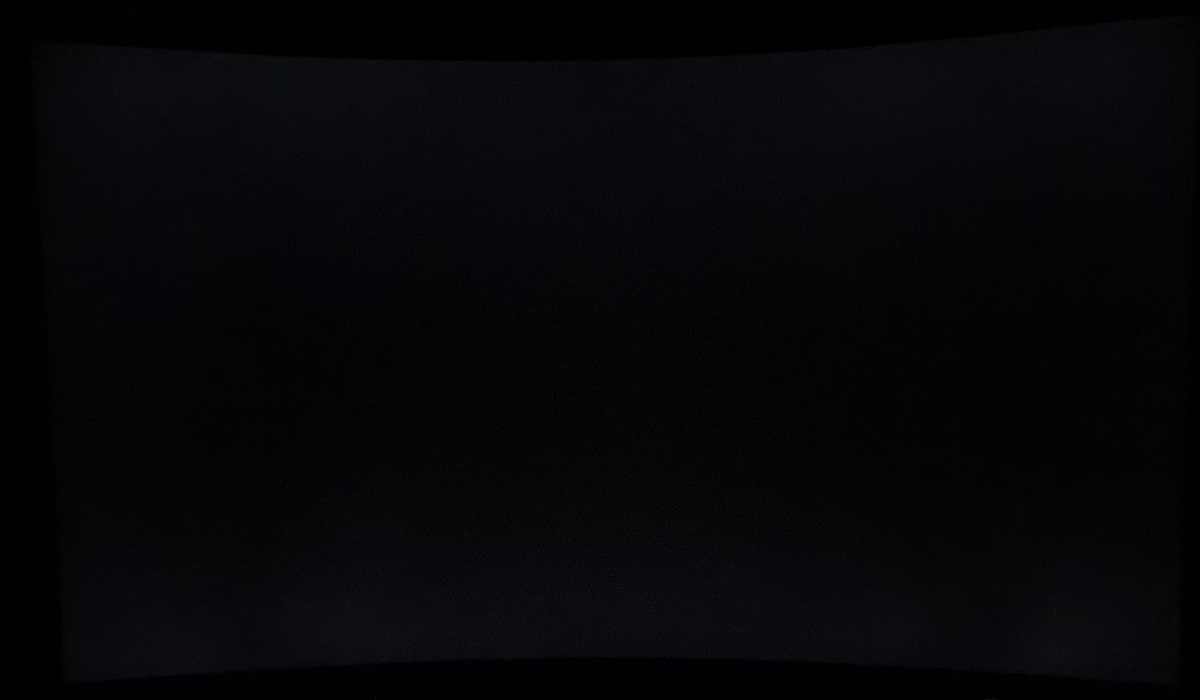
The SpyderX Elite was used to assess the uniformity of lighter shades, represented by 9 equally spaced white quadrants running from the top left to bottom right of the screen. The table below shows the luminance recorded at each quadrant as well as the percentage deviation between each quadrant and the brightest recorded point.

Luminance uniformity table
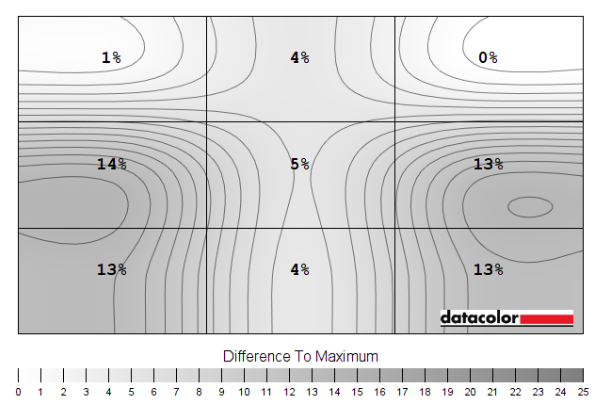
Luminance uniformity map
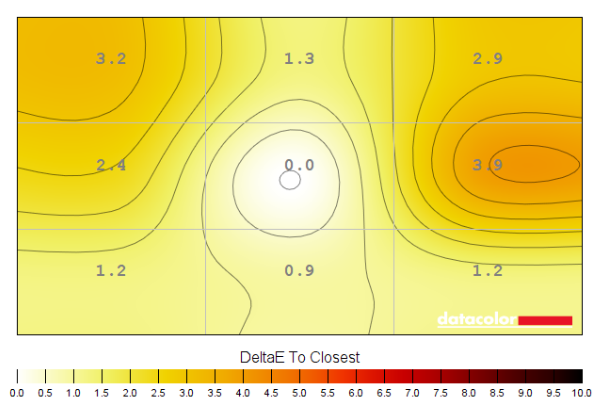
Colour temperature uniformity map
Contrast in games and movies
Lagom contrast tests
Colour reproduction
Colour gamut
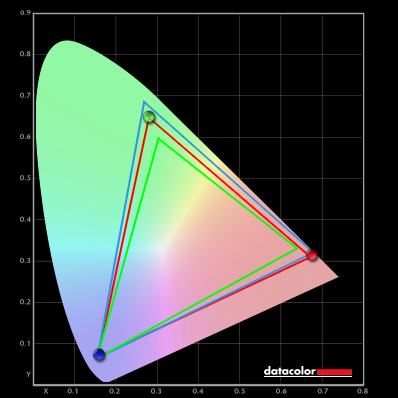
Colour gamut 'Test Settings'
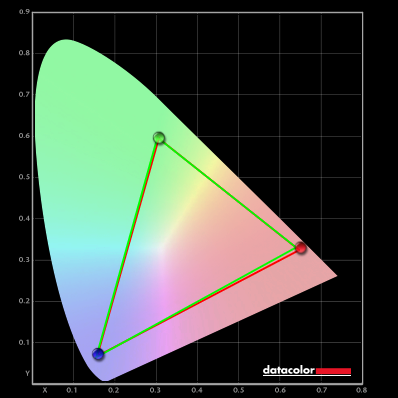
Colour gamut 'sRGB'
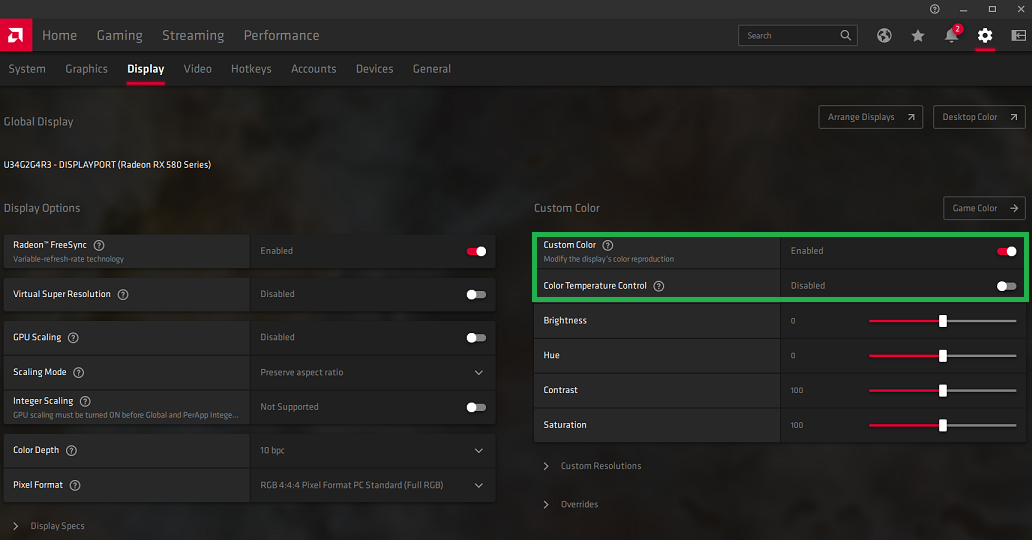
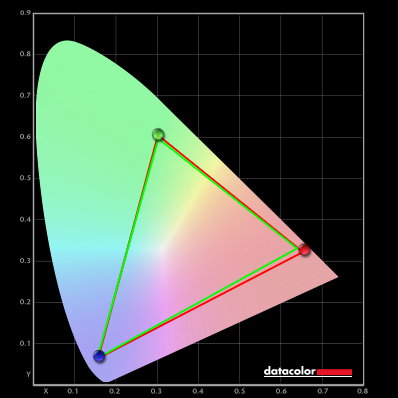
Colour gamut AMD 'CTC disabled' setting
Whilst Nvidia doesn’t have a similar option in their graphics driver, a third party tool called ‘novideo_srgb’ can be used. This provides very similar functionality to the AMD driver option and is a similarly effective GPU-side gamut clamp. The resulting gamut was very similar to that shown above with the AMD tweak – this is expected given it uses the same data from the EDID of the monitor. The tool and its usage is covered in our sRGB emulation article.
Colour in games and movies
Shade representation using SpyderCHECKR 24
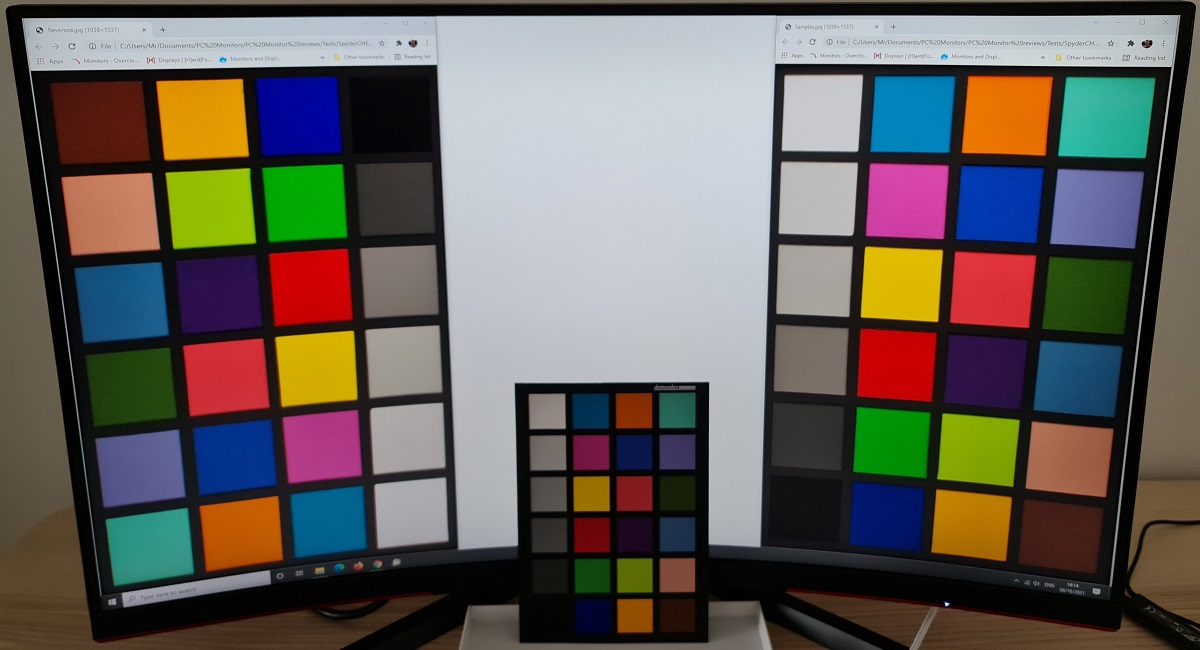
The monitor displays most shades with a dose of extra saturation and vibrancy due primarily to the extension in the colour gamut beyond sRGB. This does not occur to the same degree as on models with an even more generous colour gamut, however. The strongest saturation levels are observed when a shade is displayed further up the monitor, more directly in line with the camera (or your eyes, from an ergonomically correct viewing position). As observed in other testing earlier in the review, there are perceived gamma shifts on this model which cause saturation losses when observing content towards the bottom of the screen. And towards the extreme side edges, though that can’t be assessed with the shade layout here. These saturation losses are much lower than the vertical shifts observed on TN models and about as low as we’ve seen from a VA model – which is quite impressive given the size of the screen.
Viewing angles
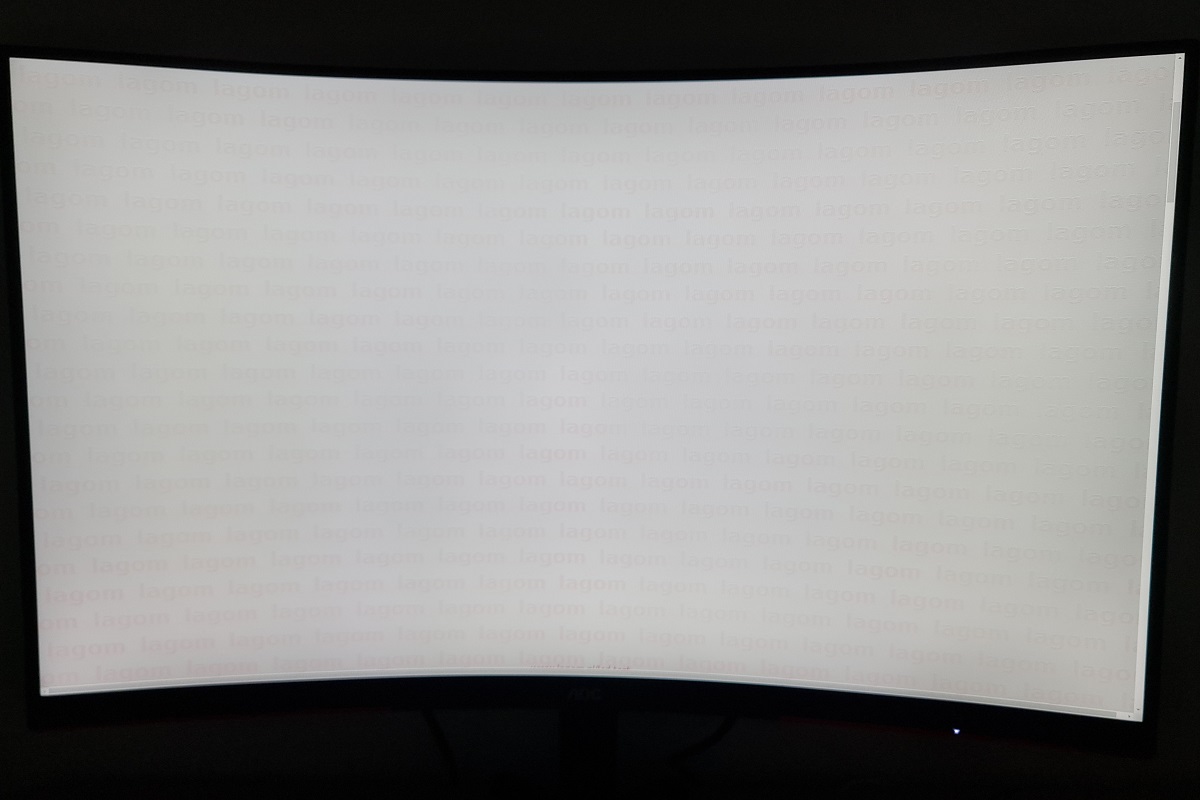
The following video shows the Lagom text test, a mixed desktop background, a game scene and dark desktop background from various viewing angles. For the mixed image and game scene you can see some shifts in colour and contrast. They’re most pronounced at steeper angles, although losses of saturation can be observed following gentler viewing position shifts. Especially horizontally and when viewed from above. There is no ‘colour inversion’ as you’d observe on a TN model and the vertical shifts are not as extreme. The final section of the video shows a dark desktop background and highlights the ‘VA glow’ mentioned earlier. This blooms out more noticeably from sharper viewing angles but is not as strong from centralised viewing angles.
Interlace pattern artifacts
Responsiveness
Input lag
Perceived blur (pursuit photography)
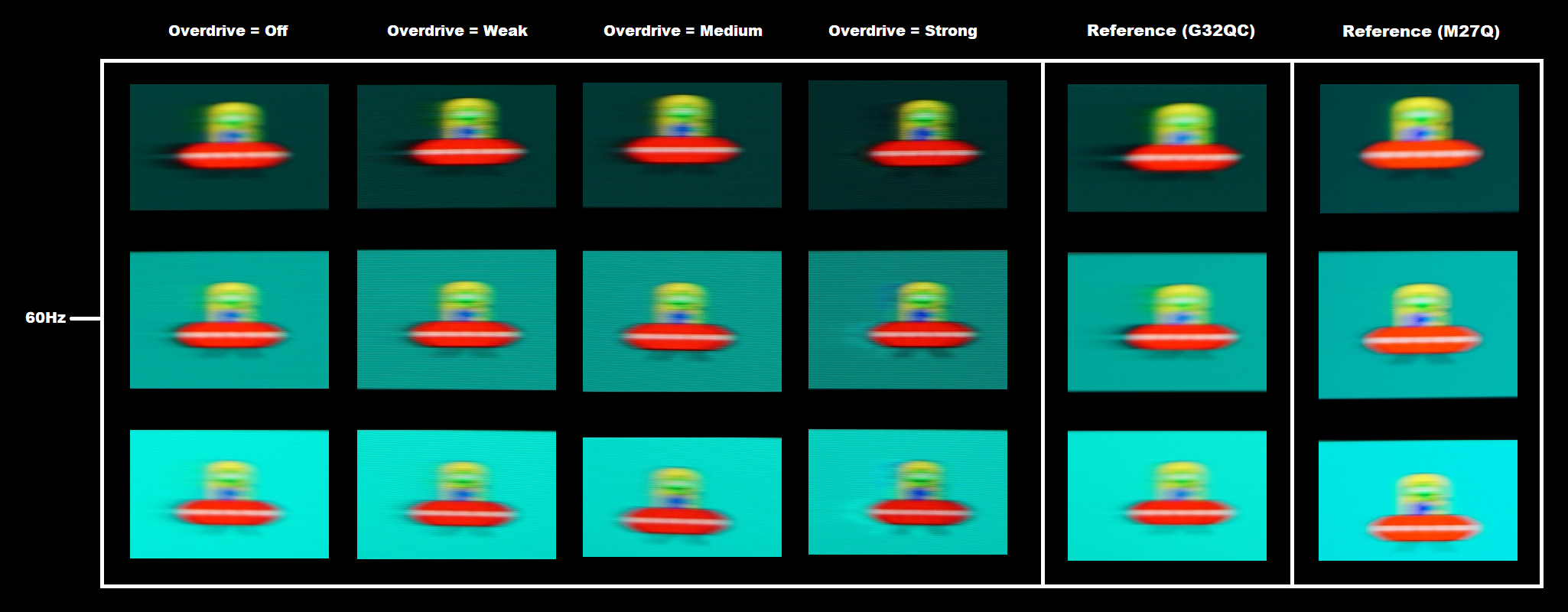
At 60Hz, shown above, the UFO appears relatively broad without clear internal detailing. This reflects a significant degree of perceived blur due to eye movement and is tied to the 60Hz refresh rate. There are also varying amounts of trailing behind the UFOs due to some weaknesses in pixel responsiveness. This trailing is boldest with ‘Overdrive = Off’ without a significant difference using the ‘Weak’ setting – aside from a slight reduction for the medium background (middle row). The ‘Medium’ setting also introduces a touch of overshoot or inverse ghosting for the medium and light (bottom row) backgrounds – ‘halo’ trailing that’s slightly brighter than the background shade. This isn’t particularly strong overshoot, however. The bold trailing remains for the dark background (top row), though is somewhat less smeary in appearance compared to weaker overdrive settings. This is removed using ‘Strong’ but replaced with strong and colourful overshoot, visible for all transitions shown in this test. We consider ‘Medium’ optimal at 60Hz, though some may consider ‘Weak’ preferable if they’re particularly sensitive to overshoot. The ‘Medium’ setting offers superior performance to the G32QC reference, but the pixel responses aren’t as rapid as the M27Q reference. The pursuit photographs below show how things looked with refresh rate bumped up significantly, to 120Hz.

At 120Hz, shown above, the UFO now appears significantly narrower with clearer focus. There are again varying degrees of trailing behind the object. Because the pixel response requirements for a optimal performance have been raised significantly, weaknesses in pixel response stand out in a much clearer way now. The dark background shows distinct ‘smeary’ trailing, with a bold trail close to the object for the medium background (replaced with overshoot using the ‘Strong’ setting). And some extended ‘powdery’ trailing for the light background, again replaced with overshoot using the ‘Strong’ setting. Based on the transitions shown here the ‘Strong’ setting may appeal to some, but there’s a fair bit of overshoot and for some transitions not assessed here it’s particularly eye-catching in our view. We consider ‘Medium’ optimal at 120Hz, with much lower overshoot levels over a broad range of transitions but a bit of a boost in pixel responsiveness compared to weaker overdrive settings. The pursuit photographs below show how things look with a further bump up to 165Hz. Note that the M27Q is set to 170Hz in this comparison, but that makes a negligible difference.
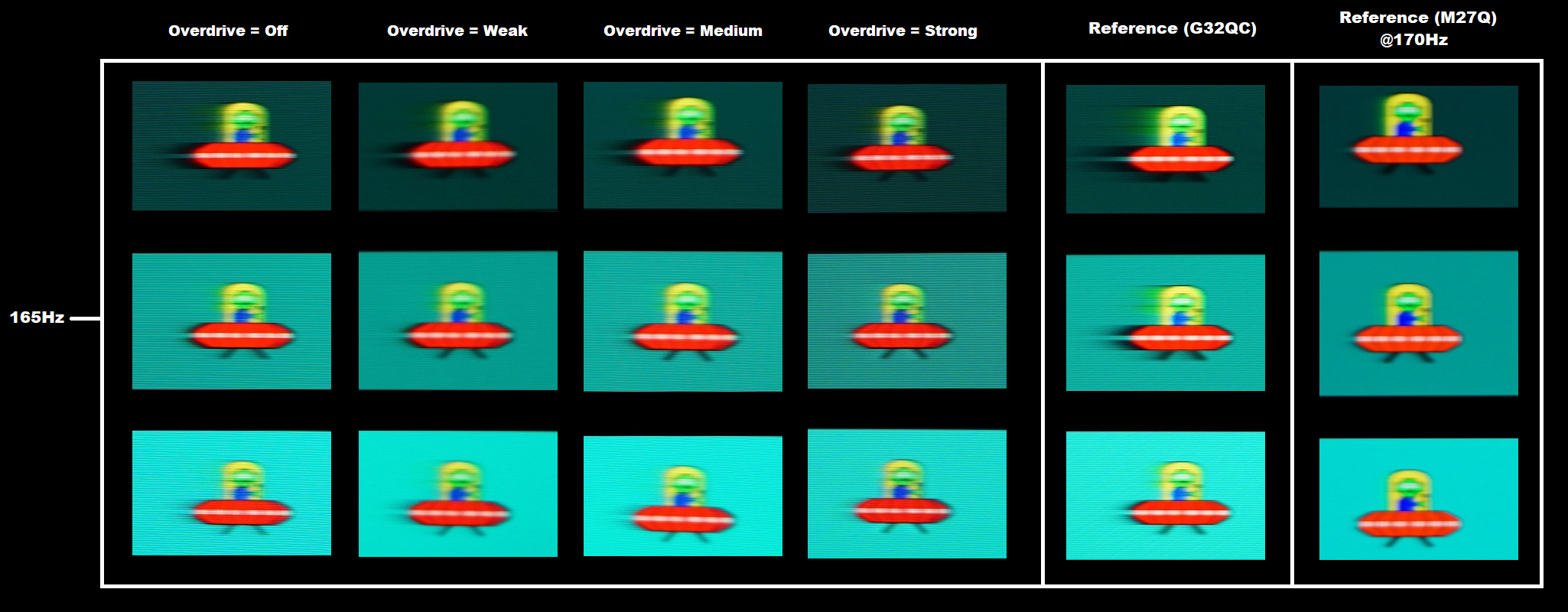
At 165Hz, shown above, the UFO appears slightly narrower again with superior detail. This reflects another decrease in perceived blur due to eye movement. The trailing extends slightly further back as the pixel response requirements for good performance are further increased. The trailing behaviour for each respective overdrive setting is largely comparable to at 120Hz, though overshoot is somewhat weaker with the ‘Strong’ setting in comparison. Some does remain, particularly if you look at the black legs against the background. And considering a broader range of transitions, we observed some obvious and eye-catching colourful ‘halo’ trailing in places using this setting. On balance we would still deem ‘Medium’ optimal here, but for those less sensitive to overshoot ‘Strong’ could still be appealing.
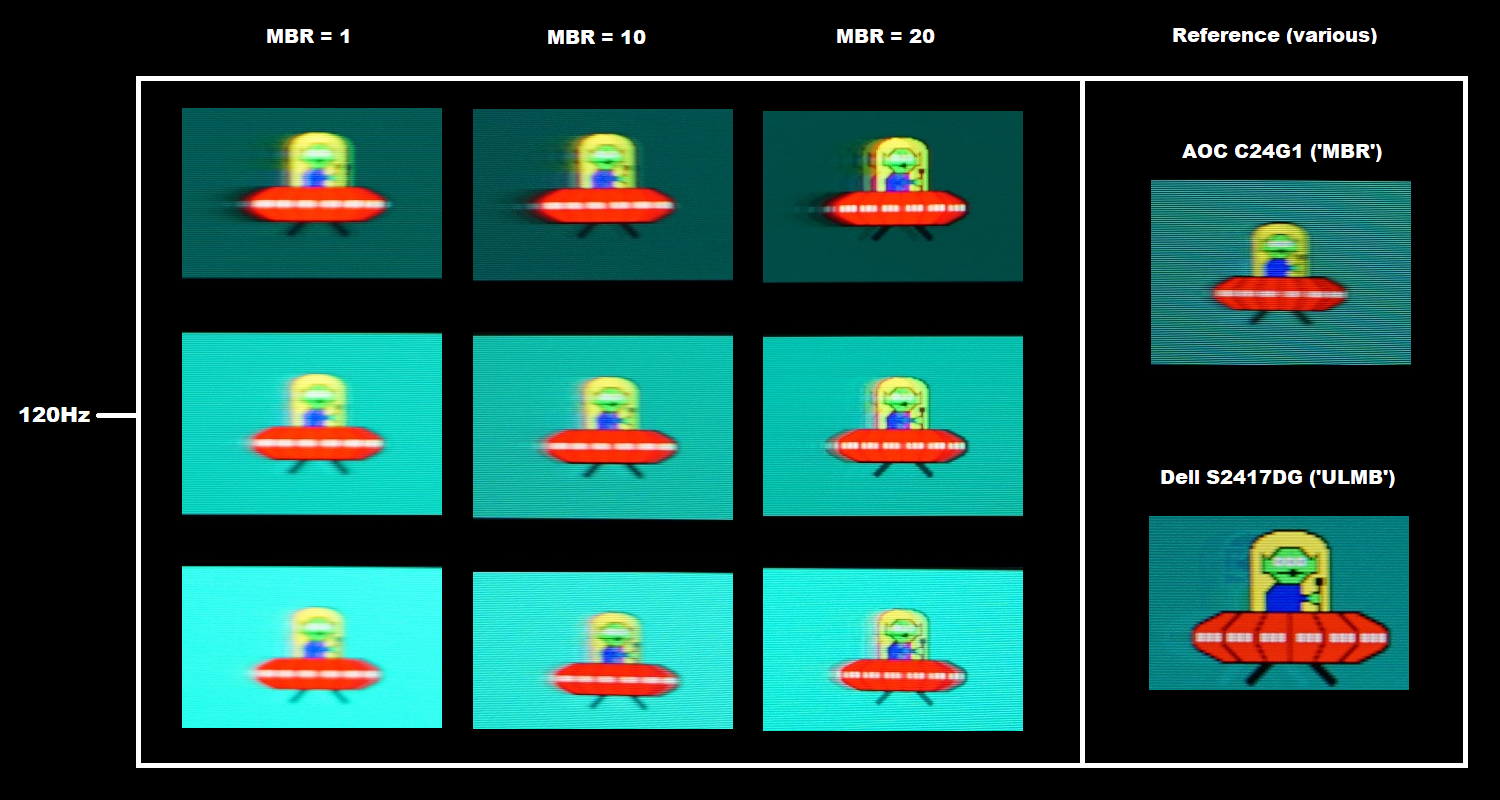
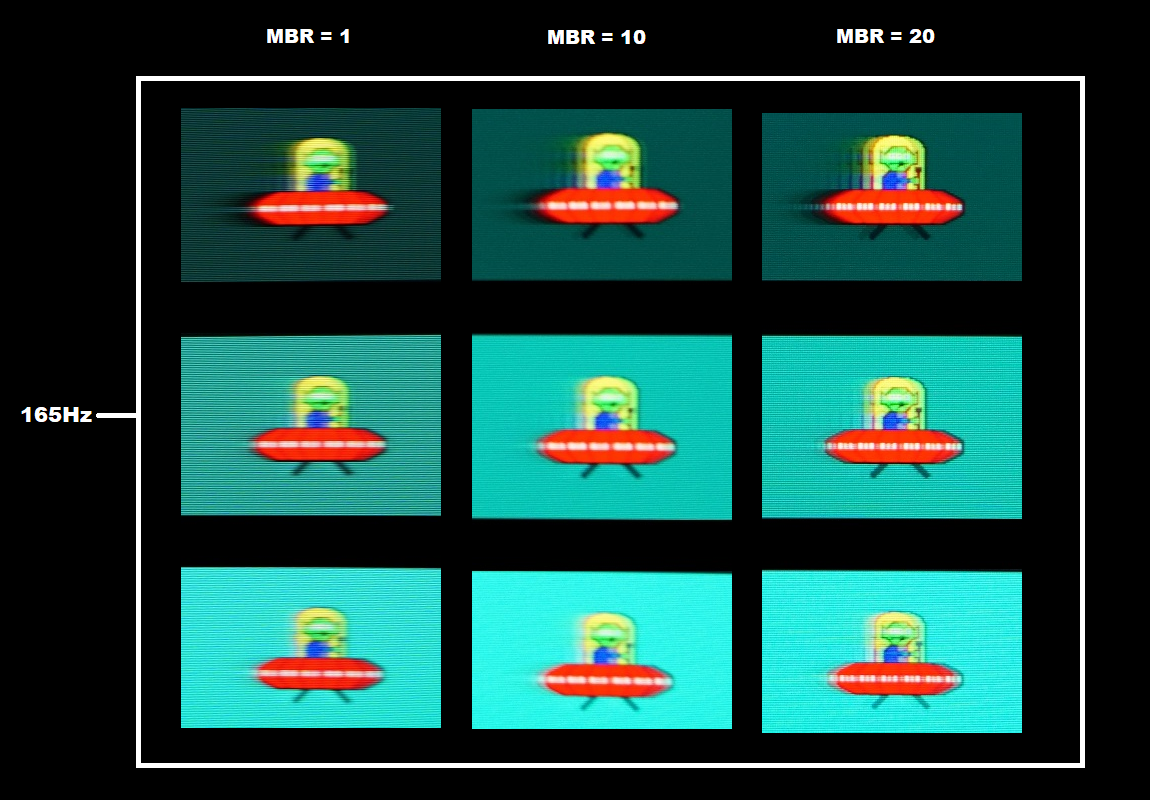
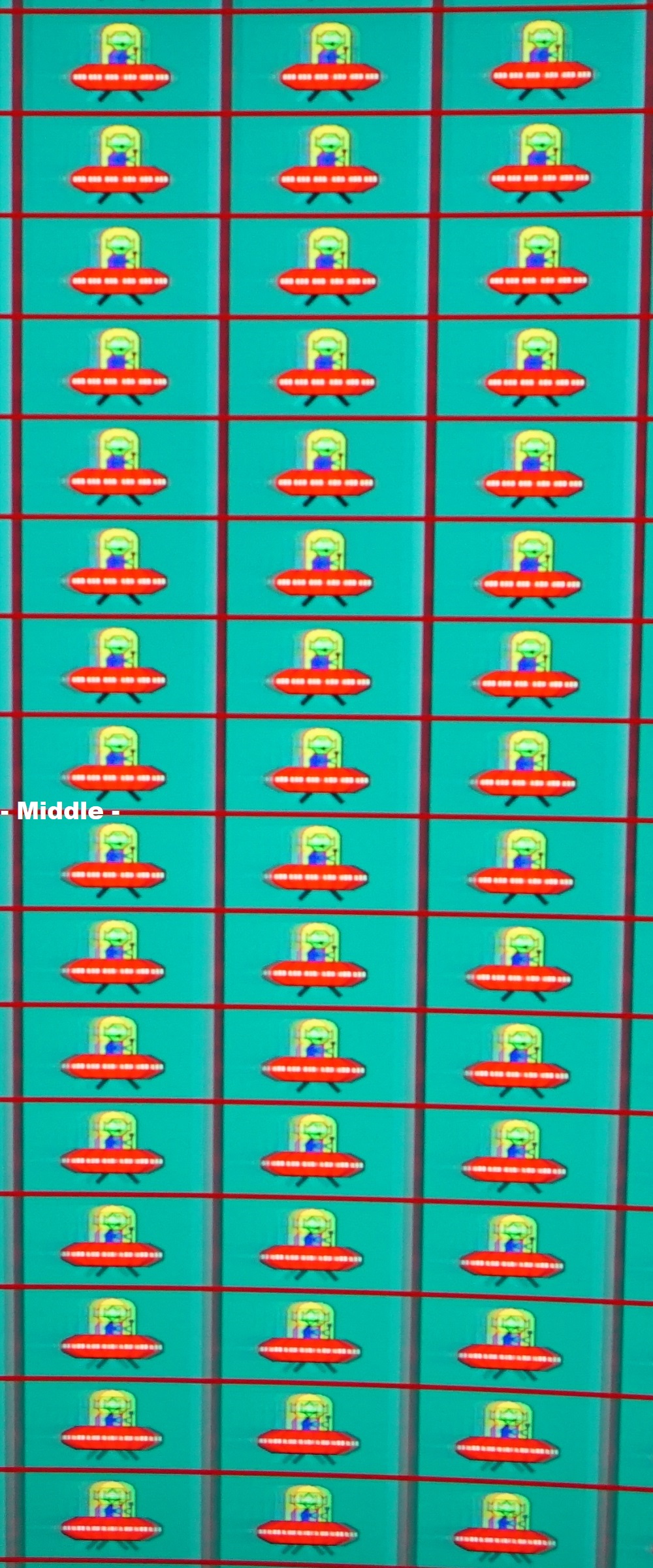
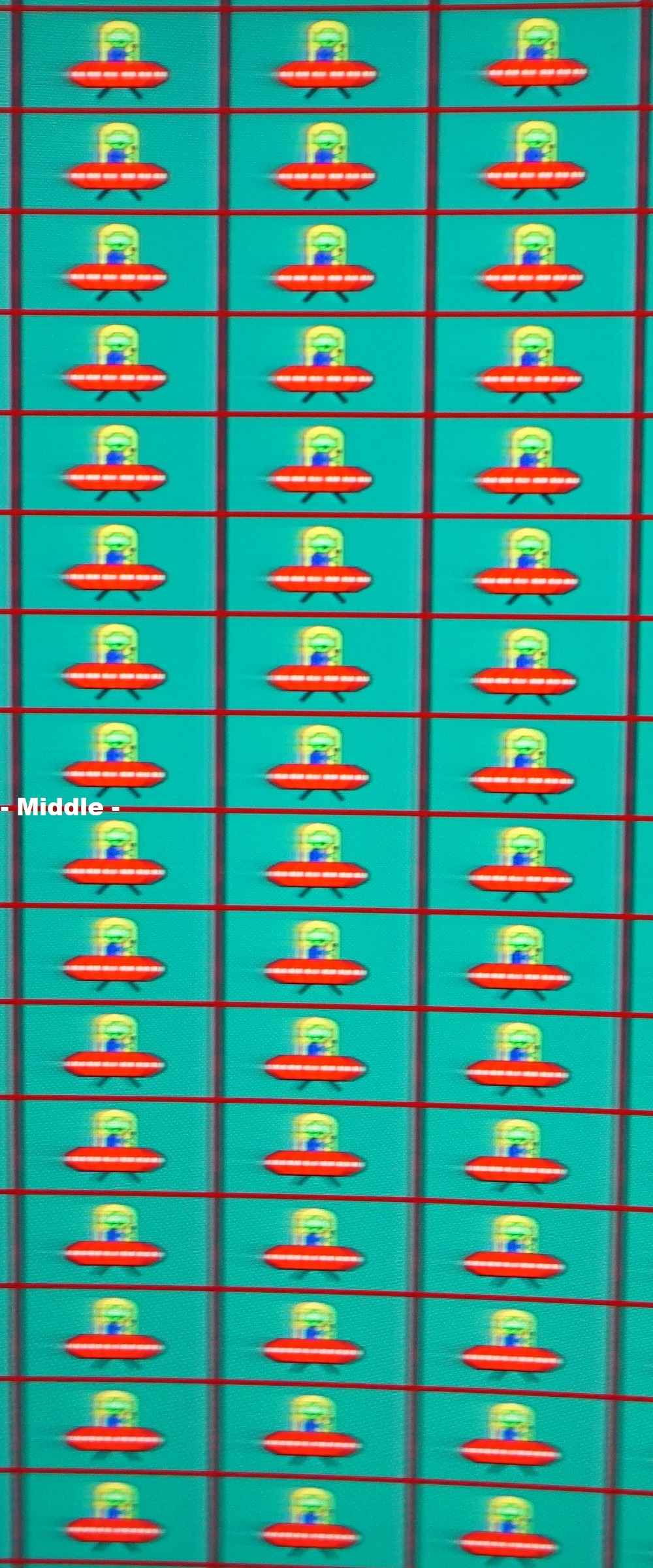
Responsiveness in games and movies

MBR (Motion Blur Reduction)
VRR (Variable Refresh Rate) technology
FreeSync – the technology and activating it
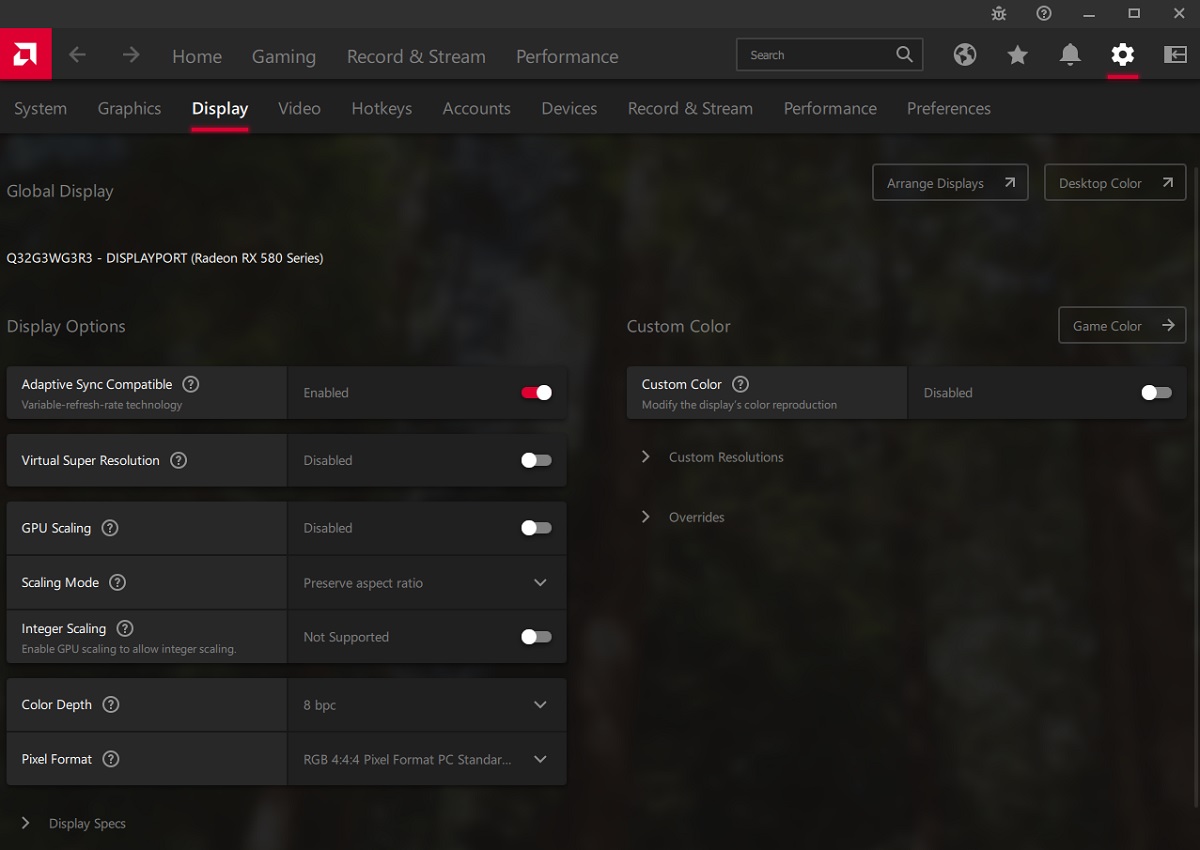

The AOC supports a variable refresh rate range of 48 – 165Hz (48 – 144Hz via HDMI). That means that if the game is running between 48fps and 165fps, the monitor will adjust its refresh rate to match. When the frame rate rises above 165fps, the monitor will stay at 165Hz and the GPU will respect your selection of ‘VSync on’ or ‘VSync off’ in the graphics driver. With ‘VSync on’ the frame rate will not be allowed to rise above 165fps, at which point VSync activates and imposes the usual associated latency penalty. With ‘VSync off’ the frame rate is free to climb as high as the GPU will output (potentially >165fps). AMD LFC (Low Framerate Compensation) is also supported by this model, which means that the refresh rate will stick to multiples of the frame rate where it falls below the 48Hz (48fps) floor of operation for FreeSync. If a game ran at 33fps, for example, the refresh rate would be 66Hz to help keep tearing and stuttering at bay. LFC sometimes seemed to activate at slightly higher refresh rates, commonly closer to 52Hz (52fps) and sometimes as high as 55Hz (55fps). It didn’t matter what static refresh rate was selected at the time (120Hz, 144Hz or 165Hz). But this slightly different floor of operation makes little difference in practice, anyway. This feature is used regardless of VSync setting, so it’s only above the ceiling of operation where the VSync setting makes a difference.
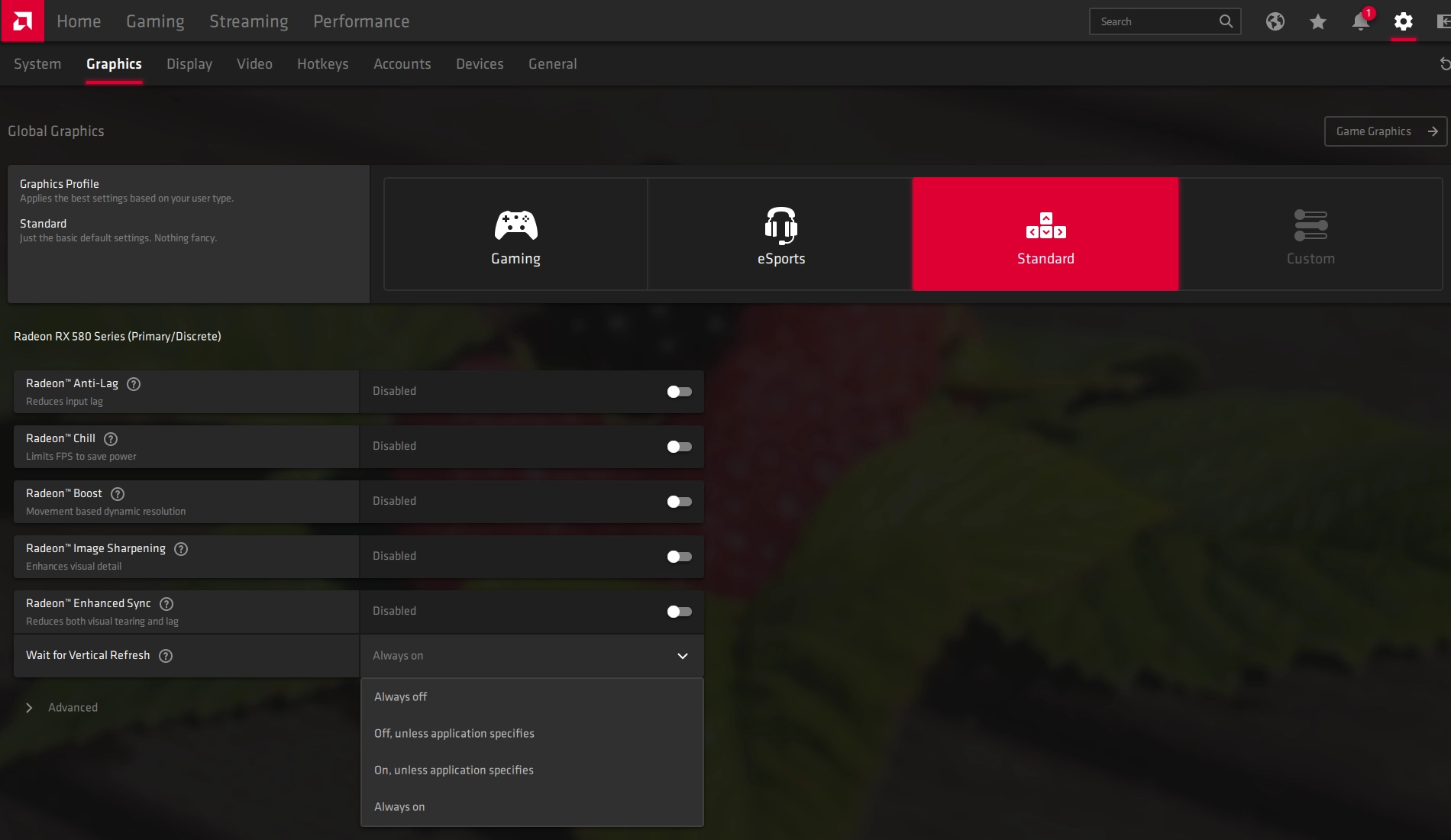
Some users prefer to leave VSync enabled but use a frame rate limiter set a few frames below the maximum supported (e.g. 162fps) instead, avoiding any VSync latency penalty at frame rates near the ceiling of operation or tearing from frame rates rising above the refresh rate. If you activate the ‘Frame Counter’ setting in the ‘Game Setting’ section of the OSD, this will display the refresh rate of the display and therefore indicate the frame rate in a VRR environment. The final point to note is that FreeSync only removes stuttering or juddering related to mismatches between frame rate and refresh rate. It can’t compensate for other interruptions to smooth game play, for example network latency or insufficient system memory. Some game engines will also show stuttering (or ‘hitching’) for various other reasons which won’t be eliminated by the technology.
FreeSync – the experience
Nvidia Adaptive-Sync (‘G-SYNC Compatible’)
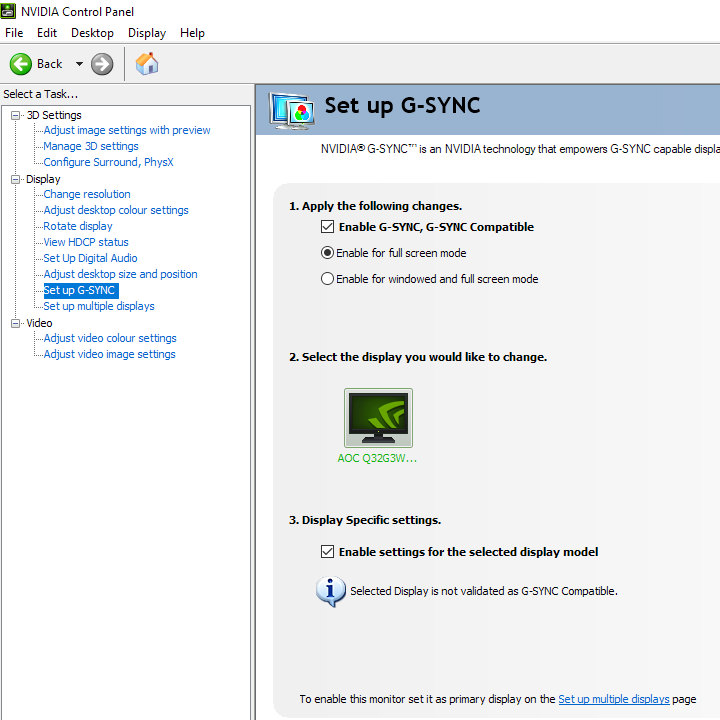
You will also see in the image above that it states: “Selected Display is not validated as G-SYNC Compatible.” The technology worked and provided a very similar experience to FreeSync on our Nvidia RTX 3090, doing its thing to remove tearing and stuttering from frame rate refresh rate mismatches. This included the apparent 55 – 165Hz VRR range, with the floor reduced by a few Hz if a lower static refresh rate is selected (e.g. 52Hz for 120Hz). An LFC-like frame to refresh multiplication technology was employed below that floor to keep tearing and stuttering from frame and refresh rate mismatches at bay. There was again a very slight momentary stuttering and sometimes slight flickering as the boundary was crossed, as we observed with our AMD GPU. And likewise, flickering during some very large refresh rate fluctuations. Not intense or at a level that will annoy everyone or necessary catch everyone’s attention, but still observable in places at a similar level to what we saw on our AMD GPU.
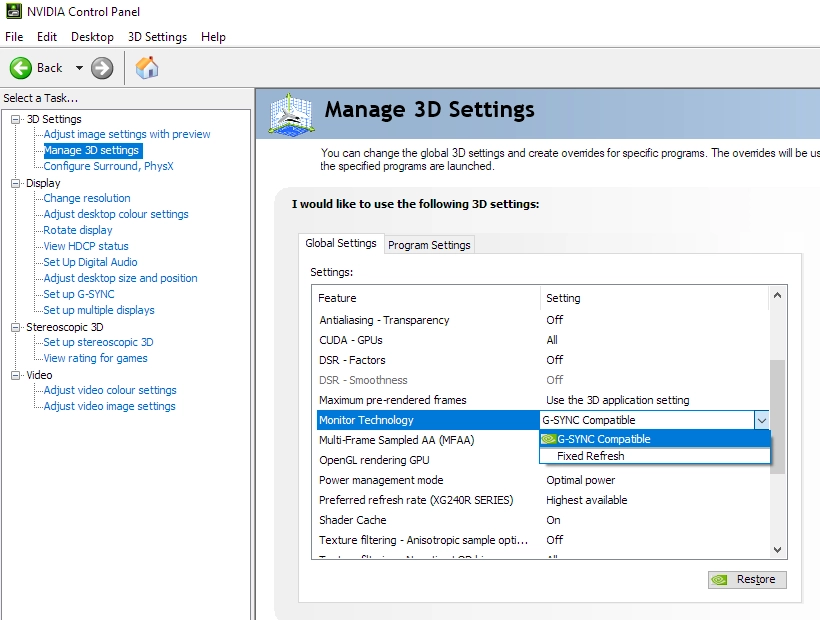
Note again that you can activate the ‘FrameCounter’ feature in the ‘Game Setting’ section of the OSD to show the current refresh rate. This will adjust as the frame rate of the content changes if it’s in the main variable refresh rate window (e.g. 55 – 165fps). And as with AMD FreeSync Premium, HDR can be used at the same time as ‘G-SYNC Compatible Mode’.
HDR (High Dynamic Range)
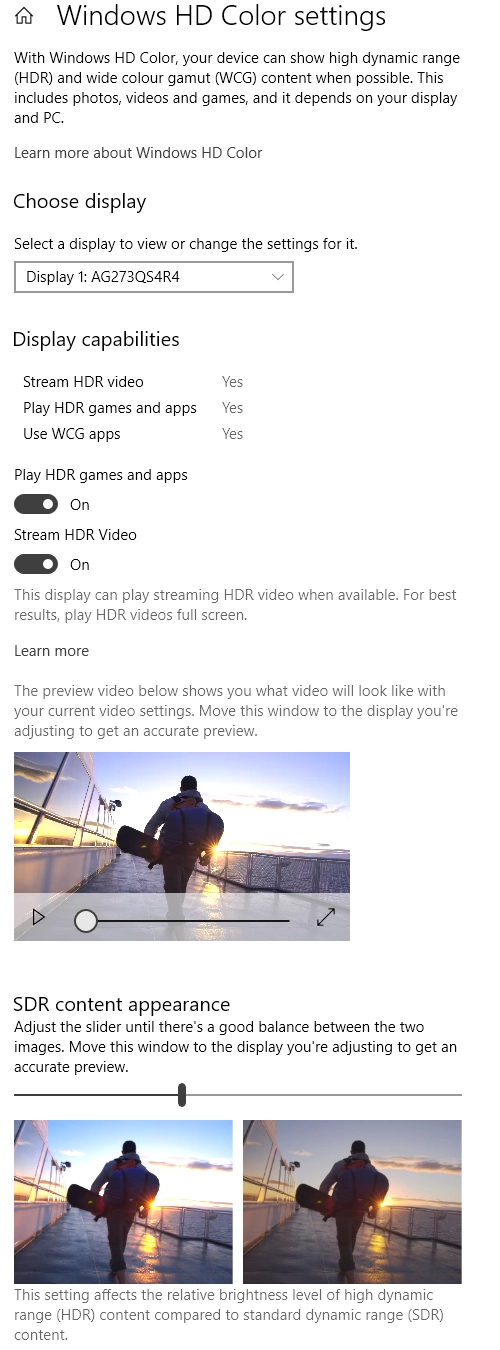

Colour gamut 'Test Settings'
The HDR10 pipeline makes use of 10-bits per colour channel, which the monitor supports via 8-bit + FRC. At some refresh rates (144Hz+ for DP, 120Hz+ for HDMI) the dithering stage is offloaded to the GPU at the native resolution, for bandwidth reasons. We’ve carefully observed a range of content (including fine gradients) on a broad range of monitors where 10-bit is supported monitor side (usually 8-bit + FRC) and where the GPU handles the dithering under HDR. Including comparisons with a given model where the monitor handles the dithering at some refresh rates and the GPU handles it at others. Regardless of how ’10-bit’ is achieved, the result is very similar in the end. It’s possible some subtle differences might be picked up during a careful side by side comparison of very specific content, but the difference is far from clear. The 10-bit colour signal enhances the nuanced shade variety, which helps the monitor put its generous colour gamut to good use. It also aids its display of very closely matching dark shades, lifting out shadow detail in a natural and ‘believable’ way and helping subtle distinctions there. Very different to what some sort of gamma enhancement under SDR might achieve. Brighter shades also benefit, with smoother gradients and more natural shades for weather effects and other fine particle effects, for example. The image below is taken from one of our favourite HDR scenes on Shadow of the Tomb Raider. Remember that the photo is purely for illustrative purposes and in no way represents how the monitor appeared running HDR in person.
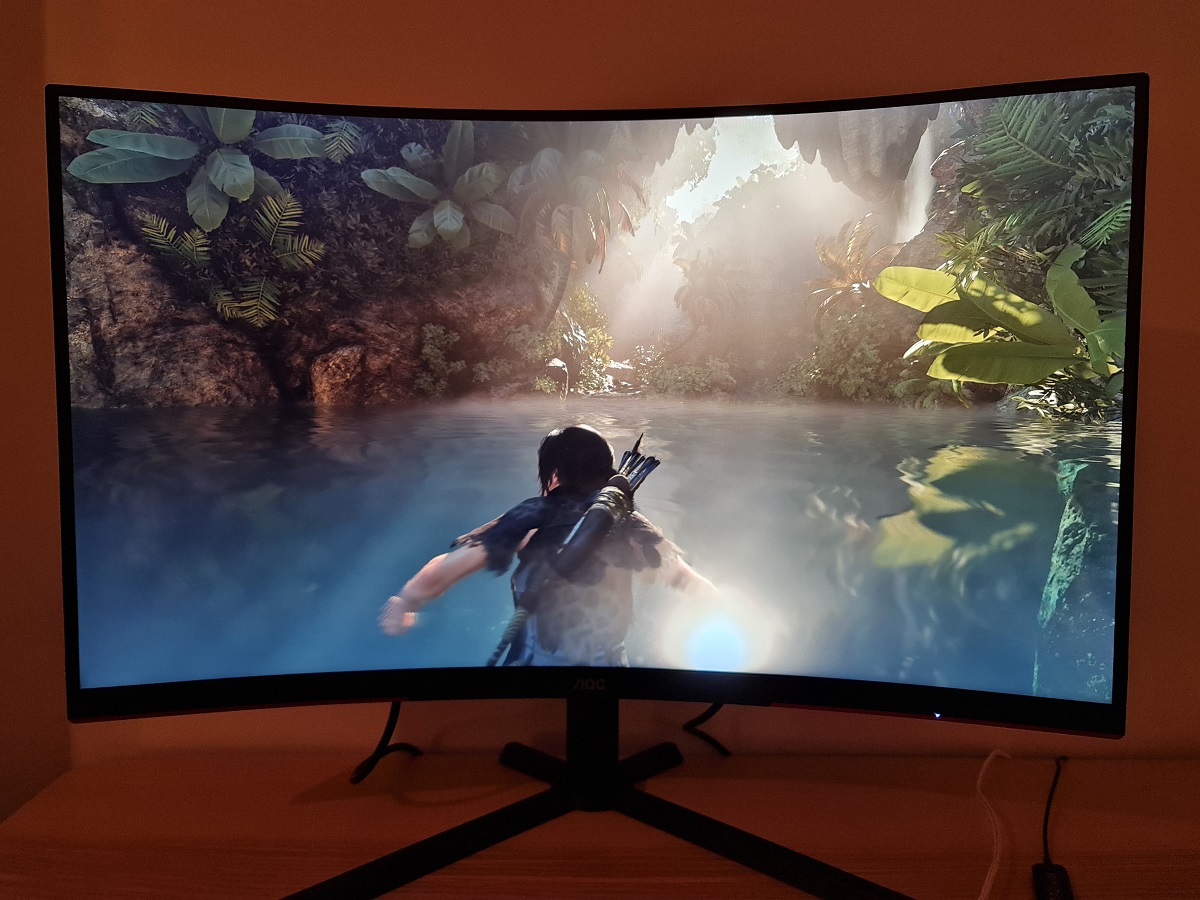
The curved 31.5″ 2560 x 1440 experience
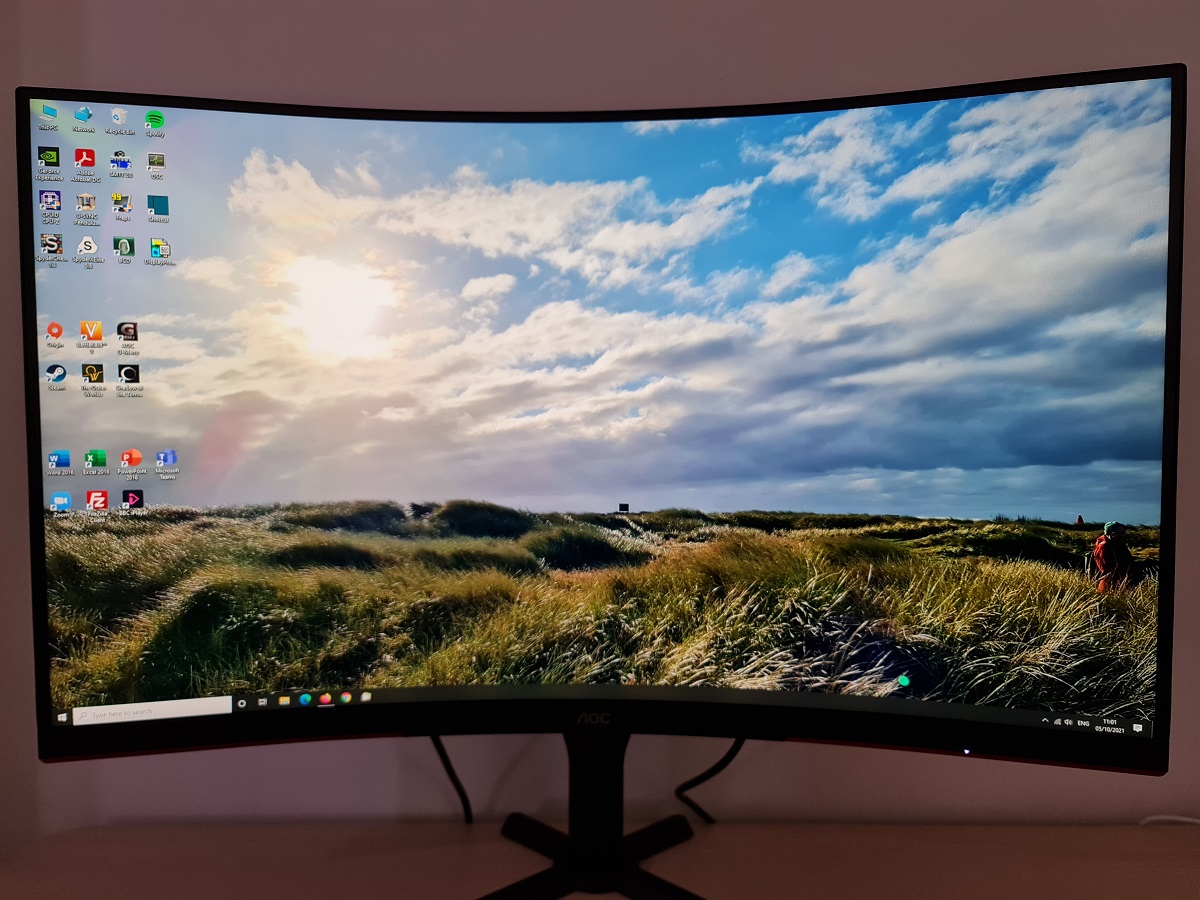
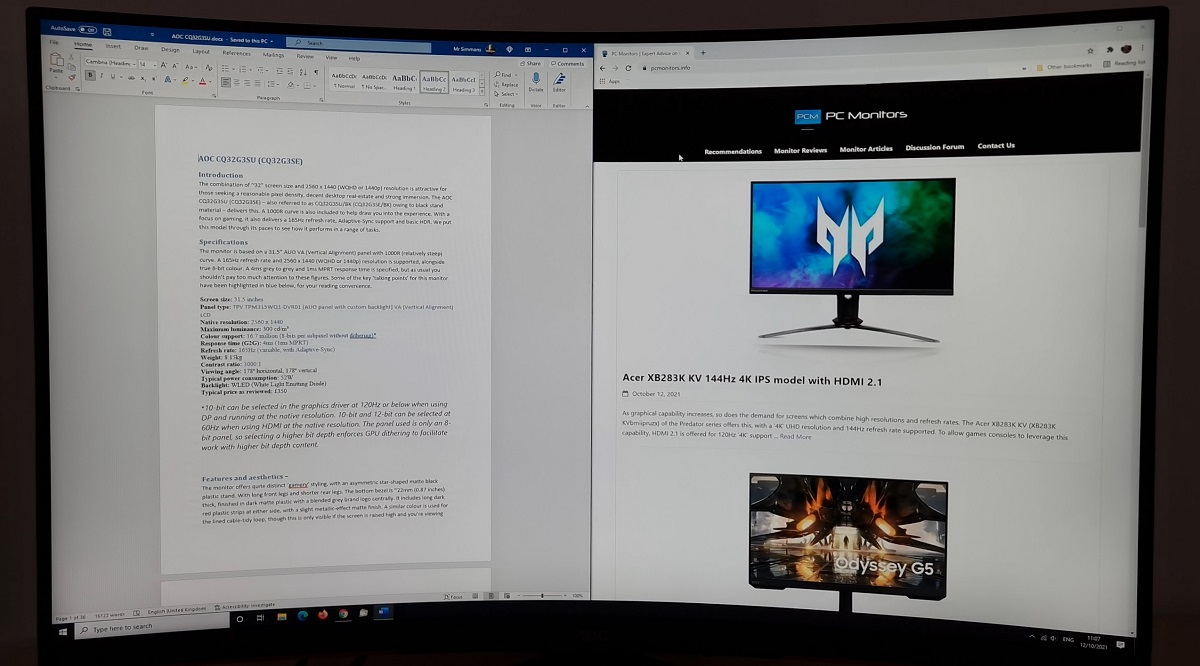
The size of the screen gives you the flexibility to sit further from it when using it for gaming and indeed other tasks. Perhaps for watching movies or playing on a games console, for example. We found the combination of size and curvature engrossing from our normal viewing position at a desk. It gave an extra sense of depth that went beyond a screen of this size with a shallower curve. When absorbed in casual gameplay or for that matter captivating fullscreen video content, we didn’t find the curve distracting. For some game titles you’ll scan your eyes across the screen from left to right (or vice versa) or move them from the centre to edges of the screen frequently. This sort of horizontal scanning makes you quite aware of the curvature – which is only 1000R on average, but shallower centrally and particularly steep nearer the edges of the screen. This sort of horizontal scanning is more common during competitive play and we’d consider this monitor more suited for casual gameplay in general, anyway. The effect of the curve and whether it’s a welcome addition or not is really quite subjective. We feel such a steep curve is somewhat better suited to a screen of this size than a 27” screen of similar curvature. But also feel it’s even more applicable to even wider screens, such as 34”+ UltraWides. The images below showcase a range of game title running on the monitor and in no way accurately show how the monitor looks in person.
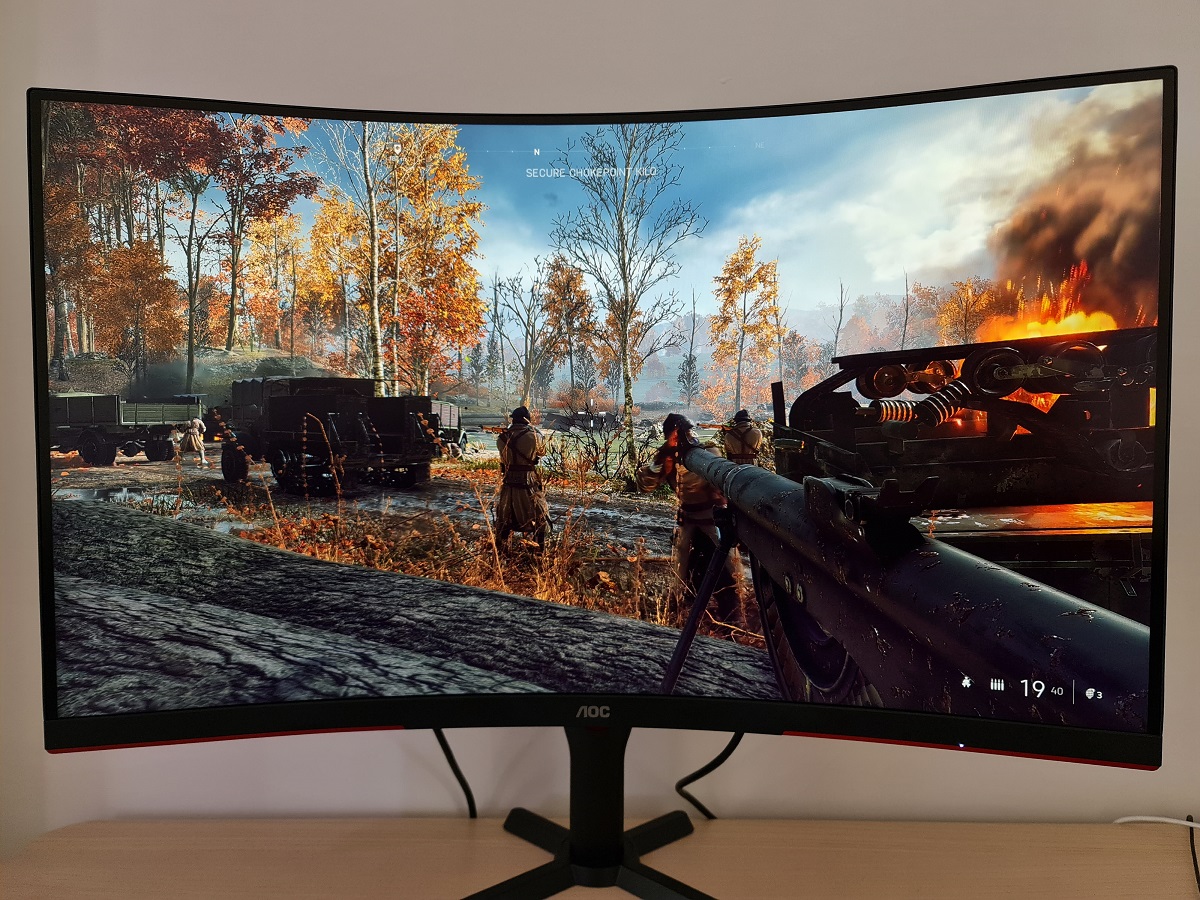
Interpolation and upscaling
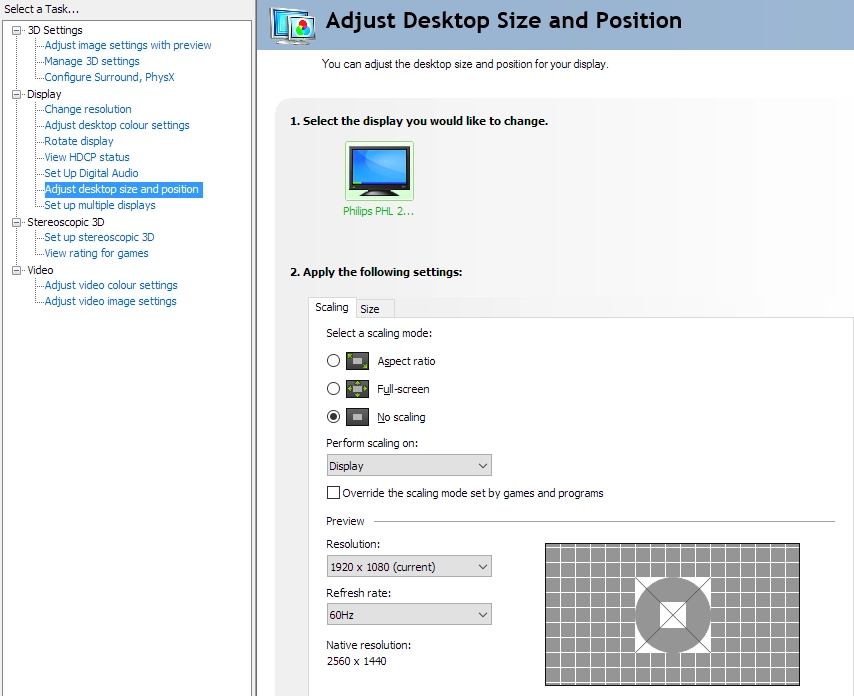
Video review
Timestamps:
Features & Aesthetics
Contrast
Colour reproduction
HDR (High Dynamic Range)
Responsiveness (General)
Responsiveness (VRR)
Conclusion
Positives Negatives Fairly vibrant colour output due to moderate extension beyond sRGB and pleasing colour consistency for the panel type
sRGB emulation inflexible including locked brightness – extended colour space coverage including DCI-P3 and Adobe RGB lacking Good edge in contrast over non-VA LCDs and basic HDR support for extra variety Contrast not overly impressive by VA standards, some ‘VA glow’ and ‘black crush’ – HDR experience limited by luminance, lack of local dimming or even Dynamic Contrast A 165Hz refresh rate with low input lag provided good ‘connected feel’ and some perceived blur advantages – VRR worked relatively well on both our AMD and Nvidia GPUs Pixel response weaknesses including some ‘smeary’ dark shade trailing. Minor flickering issues under VRR, though not particularly widespread or intense Good ergonomics, good ‘desktop real-estate’ from the 2560 x 1440 resolution and strong immersion from the screen size added to by the curve Pixel density reasonable but not particularly high and some subpixel-related softening to fine edges. 1000R curve is relatively steep and defines the experience – it won’t be to everyone’s taste


